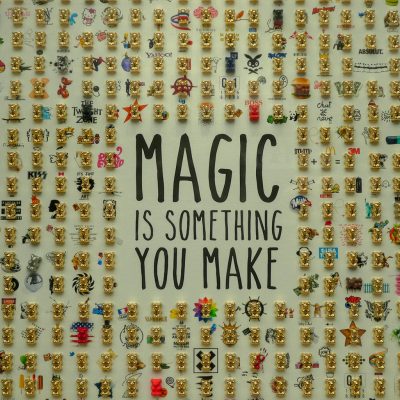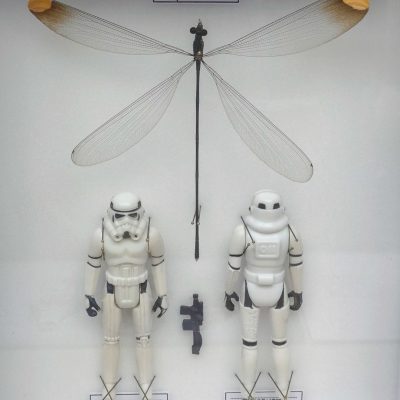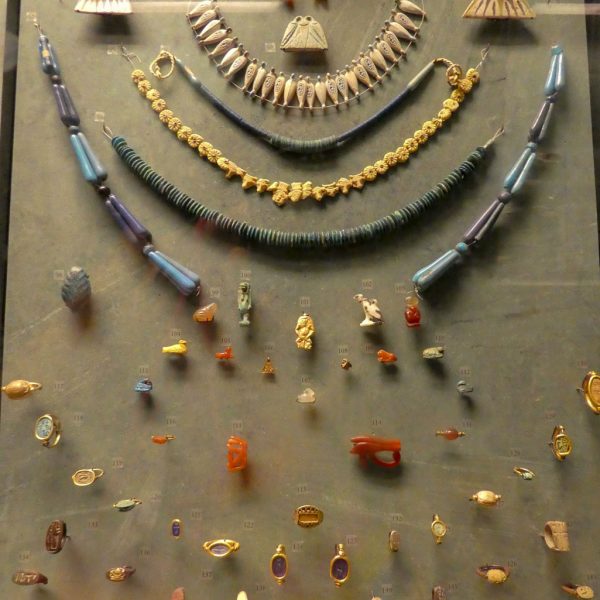Off on our hols! Paris here we come . . . I’d researched Paris very thoroughly from the internet and three great Paris  guidebooks: Top Ten DK Paris Eyewitness Travel; Marco Polo Paris and Paris Everything you ever wanted to know, Lonely Planet Guide. This last book providing a lot of really interesting extras particularly aimed at children . So I had planned our itinerary to cover as much of Paris as possible in the few days we had. Unfortunately Pal has work to do so it’s just a trip for myself, our daughter Mila and my sister Catherine.
guidebooks: Top Ten DK Paris Eyewitness Travel; Marco Polo Paris and Paris Everything you ever wanted to know, Lonely Planet Guide. This last book providing a lot of really interesting extras particularly aimed at children . So I had planned our itinerary to cover as much of Paris as possible in the few days we had. Unfortunately Pal has work to do so it’s just a trip for myself, our daughter Mila and my sister Catherine.
It’s the first time Catherine and I have been on the Eurostar and it couldn’t have been easier. Getting through security at St Pancras was painless, so much easier than flying and Pal organised us great seats on the train.
A game of Canasta, a read of our books and in no time at all the train was drawing into the Gard de Nord station, Paris. Despite one of the main lines being down for maintenance, there were so many students in pale blue tabards, all speaking fluent English on hand to help, making travelling a breeze.
After dropping off our luggage at our hotel, Le Meridien Etoile, it was off to explore the local area. Only about 10-15 mins walk from the hotel we had our first view of the Arc de Triomphe, spectacular! It’s stands in the middle of the world’s largest roundabout in the middle of Place Charles de Gaulle, where twelve avenues meet at the western end of the Champ-Élysées. Built between 1806 and 1836 in honour of those who fought for France, especially those who fought in the Napoleonic Wars.
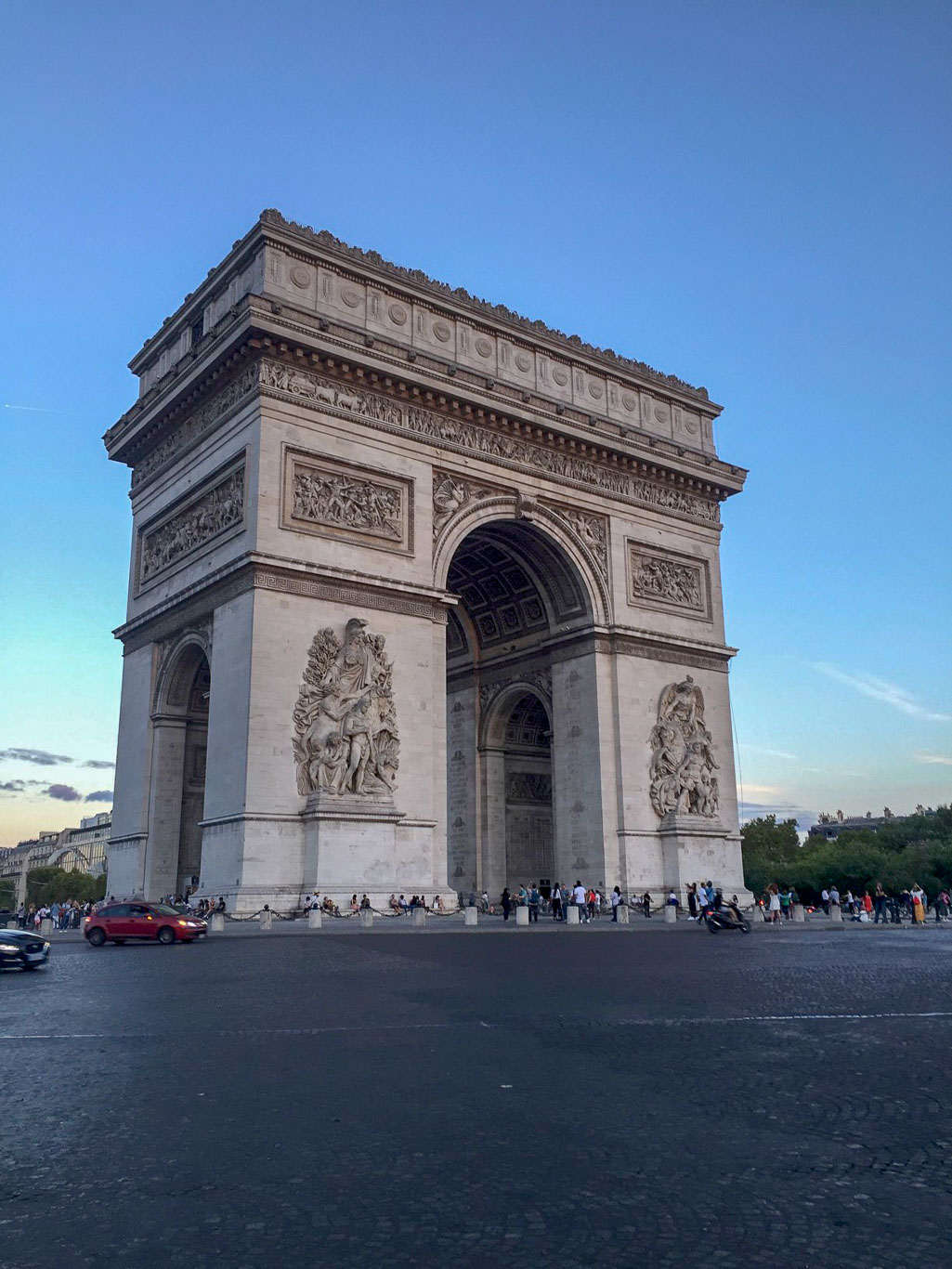
Beneath the arch is the Tomb of the Unknown Soldier from World War 1, a memorial to remember all French soldiers killed in battle. The Memorial Flame has been burning since 1921 and is rekindled each evening at 6.30pm.
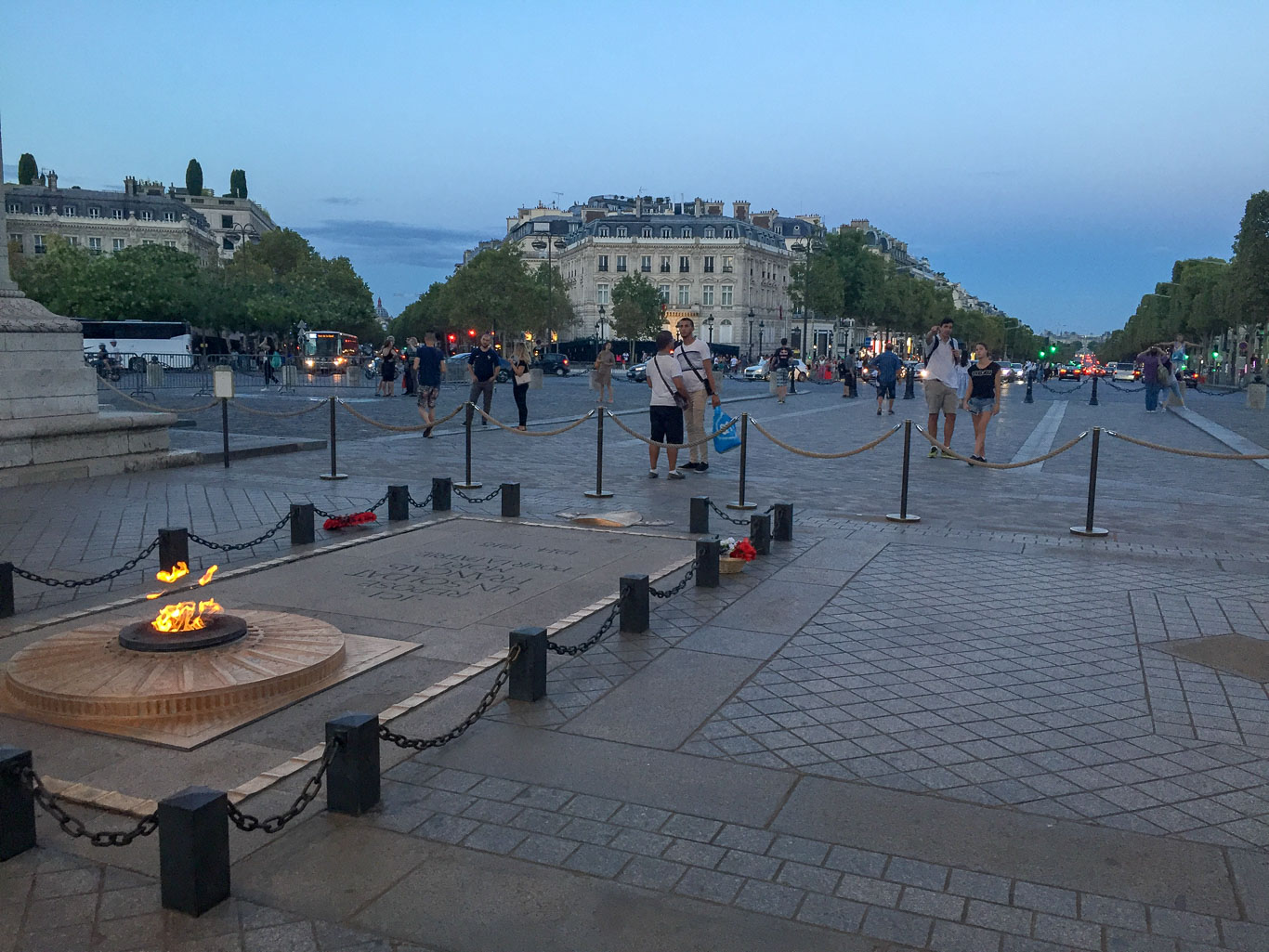
We also had our first sighting of the Eiffel Tower!
We planned to walk down the Champ-Élysées the next day . . . For now, it was back to the hotel for a shower and sleep, I’ve planned a really busy day walking for tomorrow.
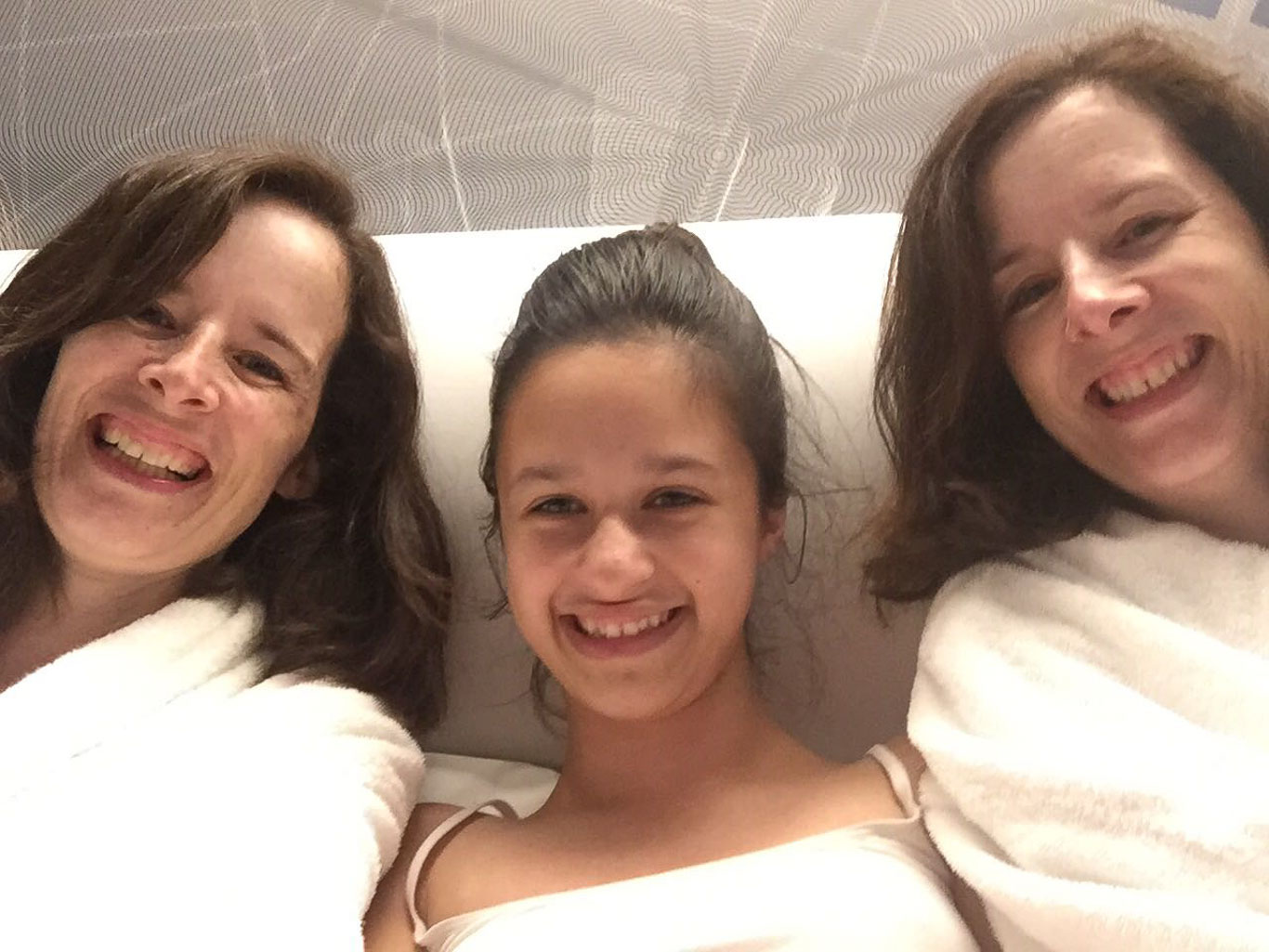
WALKING PARIS – was the theme for Tuesday 31st July though we only ended up walking a mere 13.4 miles compared to 15.6 miles on Wednesday!
The Grand Palais on one side of the road . . .
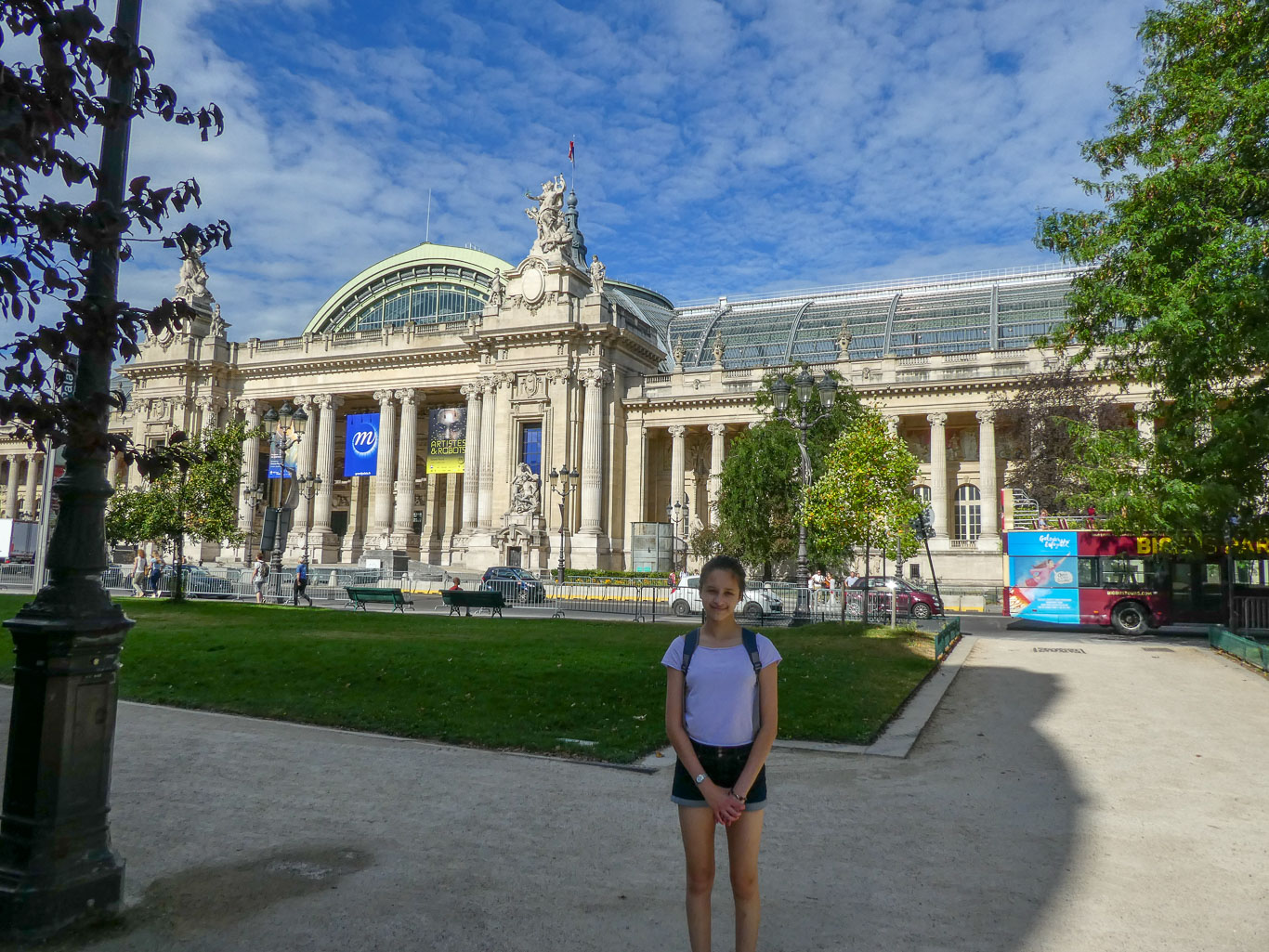
. . . with the Petit Palais opposite.
Mila and Catherine with the Petit Palais in the background.

The Petit Palais had free entrance so we decided to visit though because we had such a busy day planned we decided to put off the Impressionist Exhibition which we would have loved to view but with so much to see in only a few days we just enjoyed the other exhibits and the garden cafe instead.
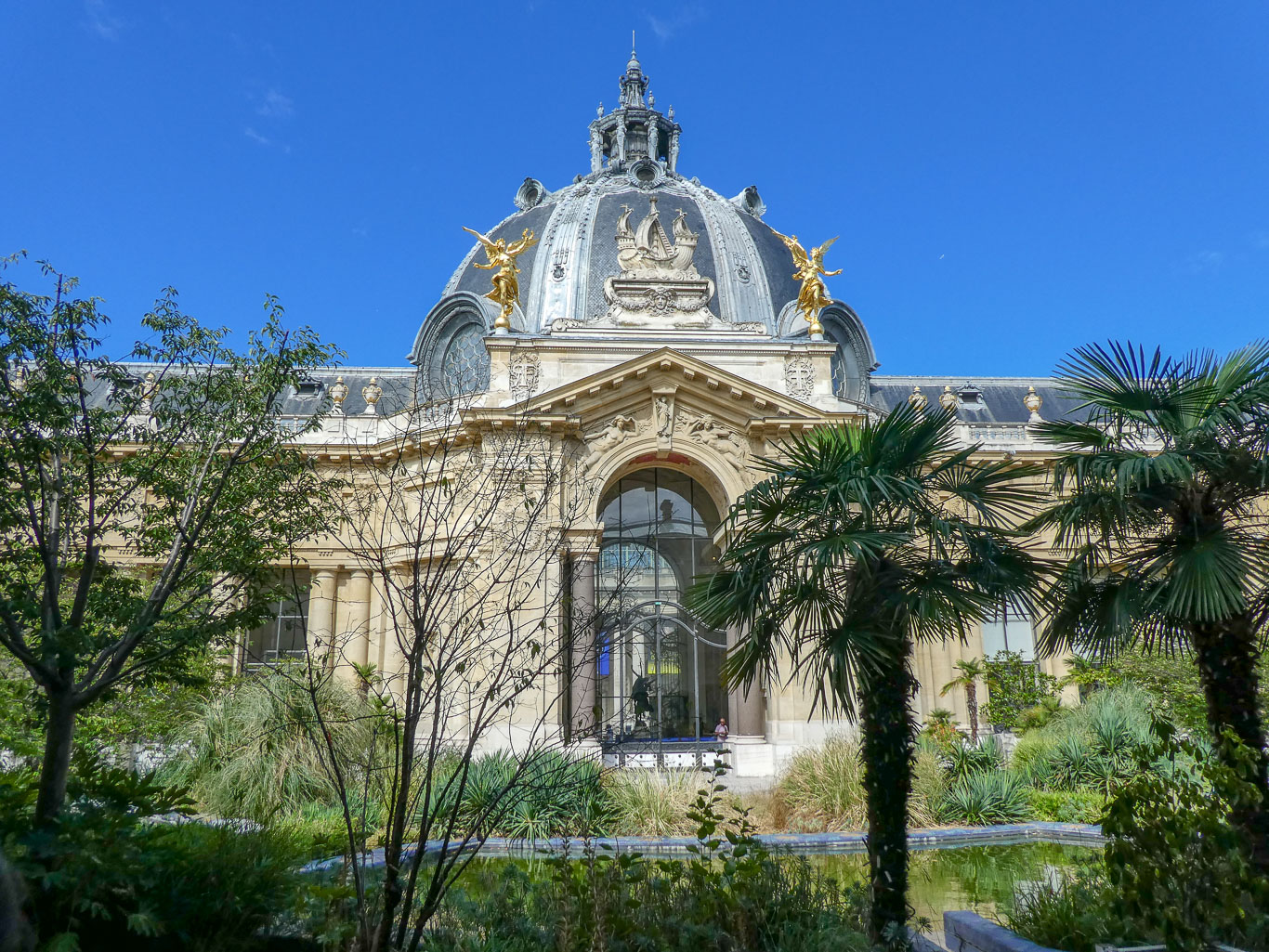
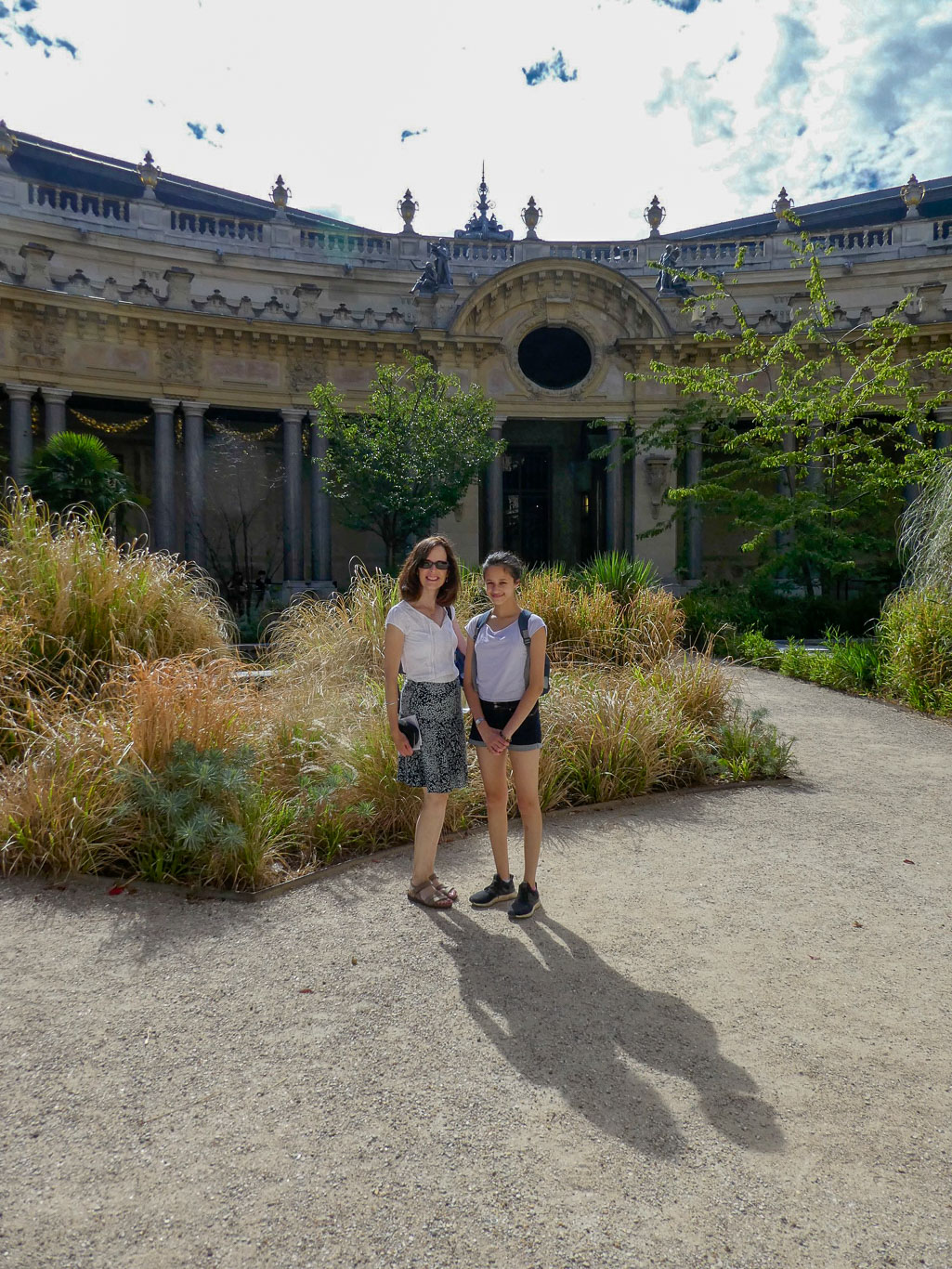
There never seems to be many good photos of Mila and I so I’ve included an extra photo here, simply because it’s a flattering one!
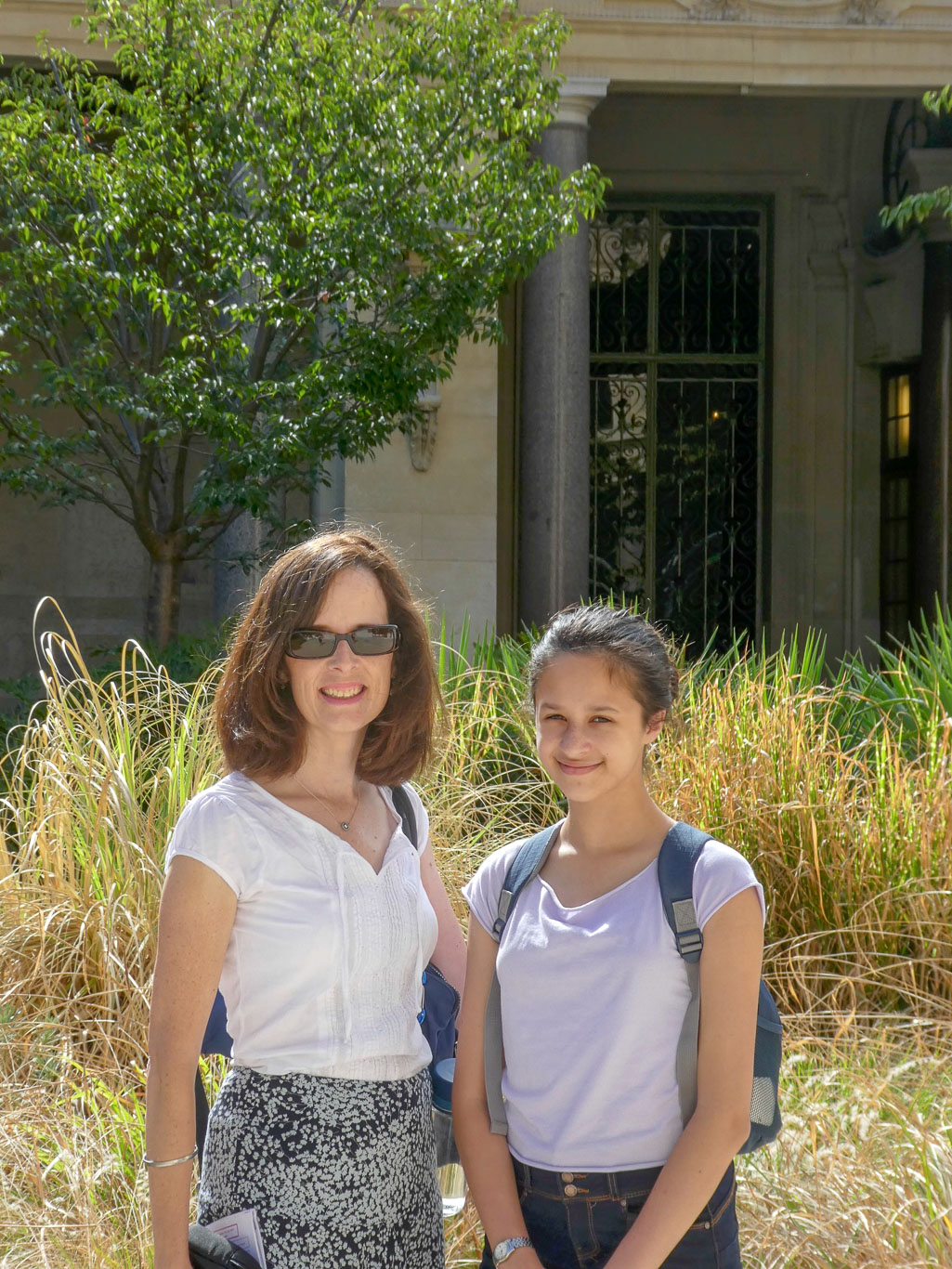 Now time for a coffee in the delightful garden cafe. A perfect spot to watch the birds . . .
Now time for a coffee in the delightful garden cafe. A perfect spot to watch the birds . . .
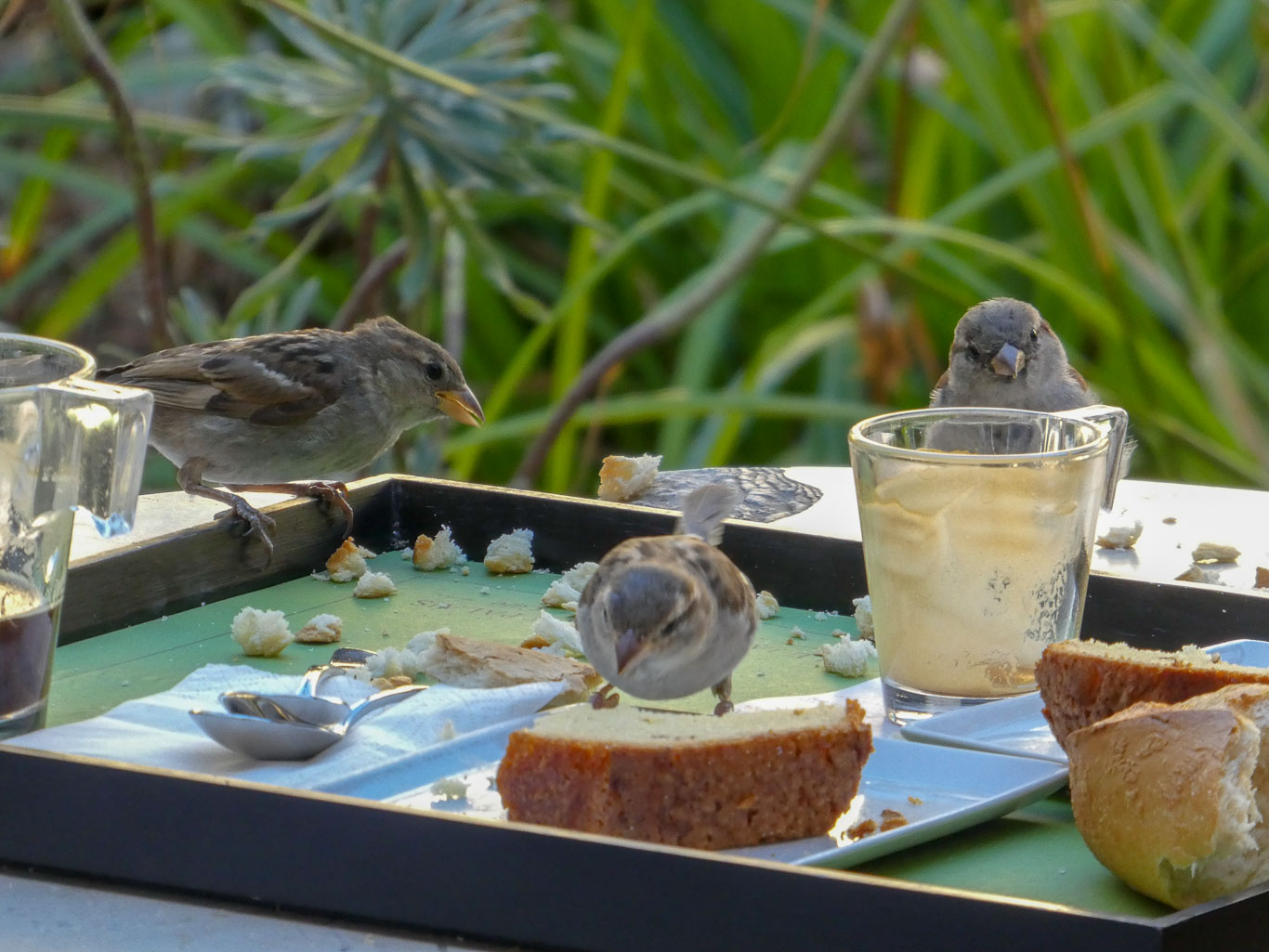
. . . and enjoy our first cup of coffee in Paris . . .

We saw some amazing works of art . . . Including the ceiling . . . walls and windows.
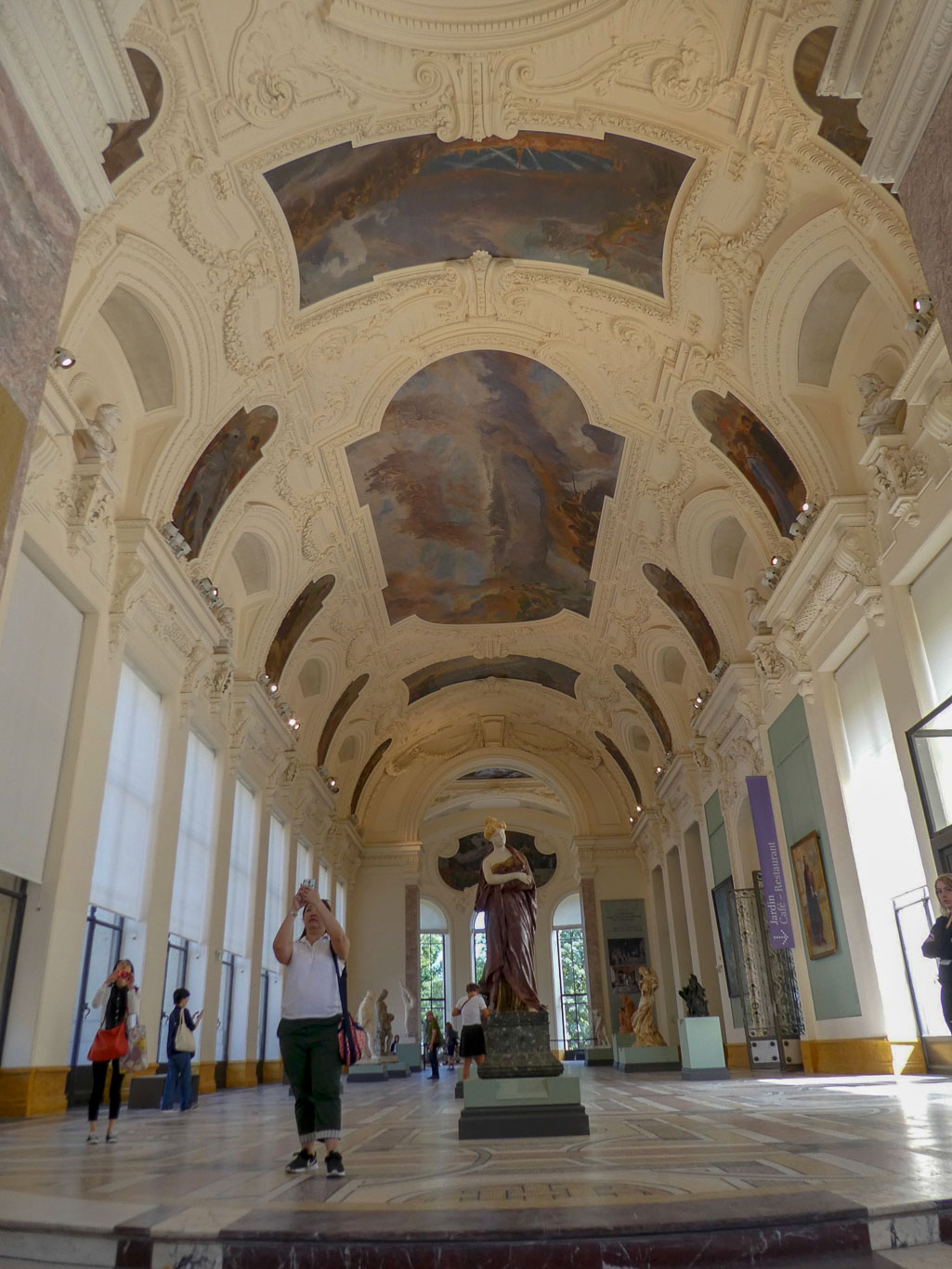
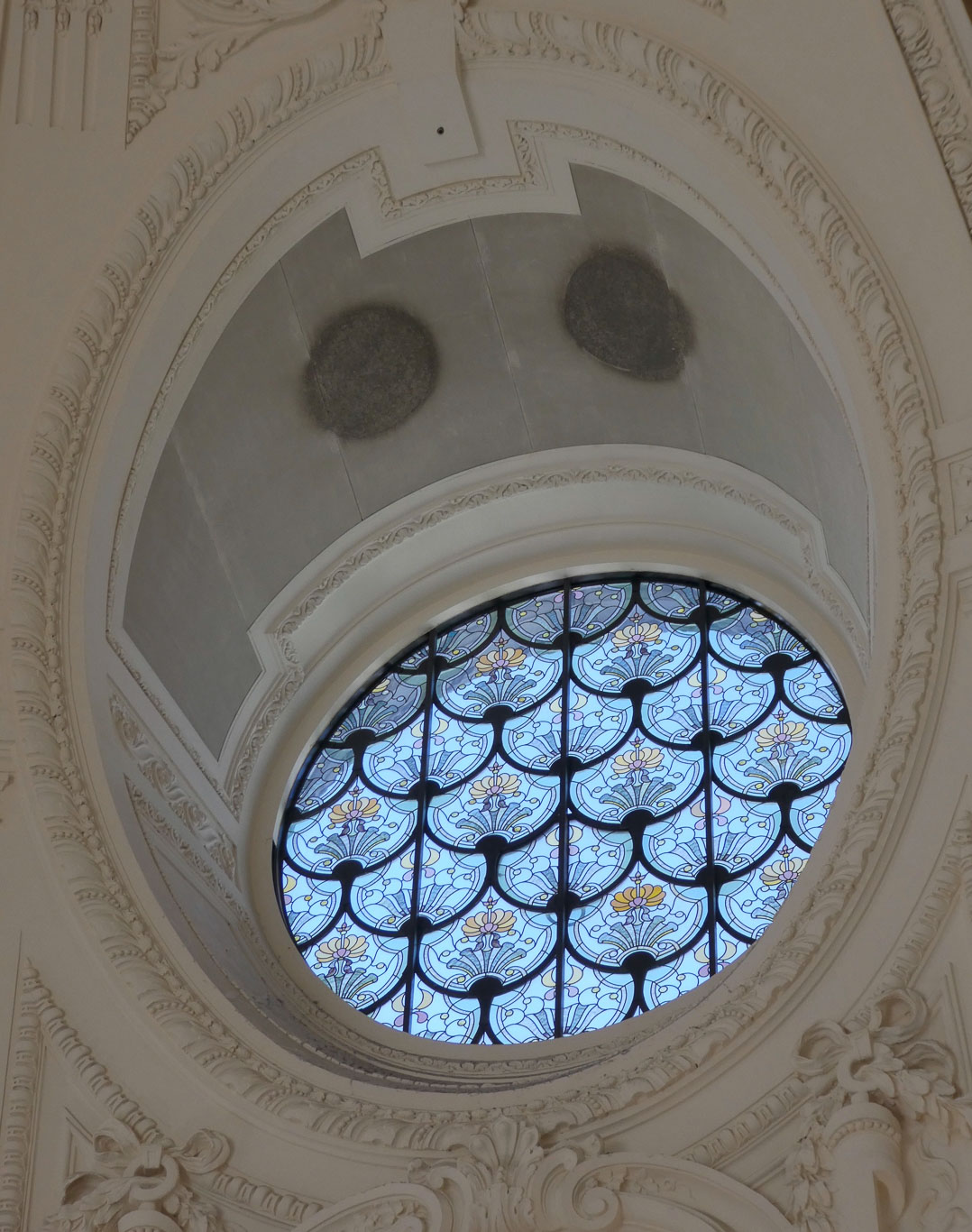
On our way again down the Champ-Élysées with the Eiffel Tower in the background . . .We also had our first sighting of the Eiffel Tower! Designed by Alexandre Gustave Eiffel as a temporary exhibit for the 1889 World Fair. It wasn’t even admired by many Parisians at the time! It’s 324m high, about the same height as an 80-storey building and is still the tallest structure in Paris (and was the tallest manmade structure in the world for 41 years).

We saw a few really interesting tour groups, one on bicycles but this group on Segways looked like fabulous fun, I’d love to have a go wouldn’t you?

Near the centre of Paris not far from the Rue de Rivoli are a number of beautiful streets with exquisite shops:

Don’t these look delicious?

After a delicious lunch stop it was time to explore the Louvre complex, the Carrousel du Louvre, quiet today as the museum is closed on Tuesdays.

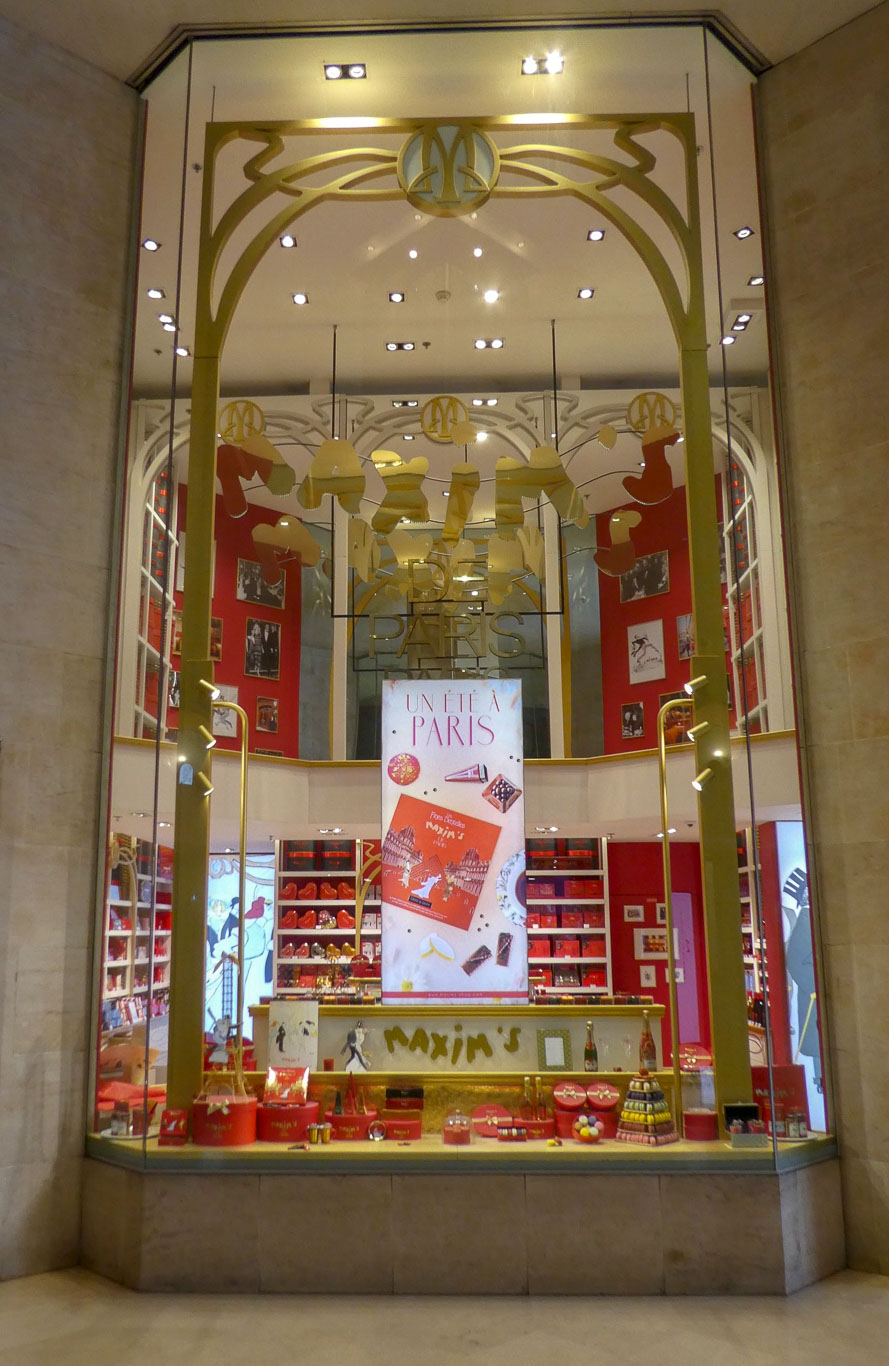
We couldn’t resist standing on the stone plinths to get the typical tourist photographs of us holding the glass pyramid outside the Louvre.


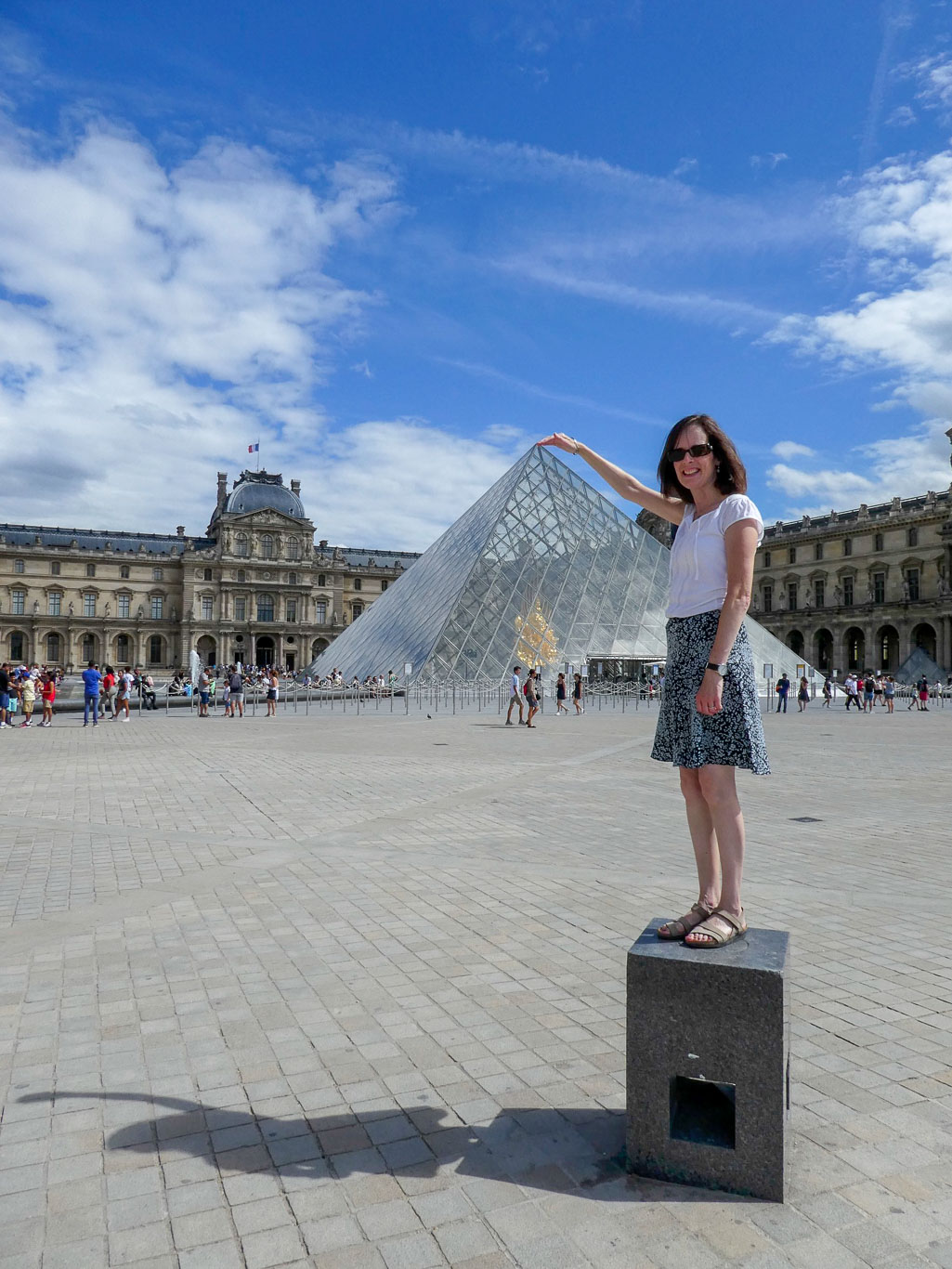
Well Catherine and I did, but Mila couldn’t be persuaded!
Its very impressive and is in fact the entrance to the huge Louvre Museum. From the glass pyramid you go down below ground then the museum itself is a labyrinth of floors and rooms which are in the buildings surrounding this central area. We ended up going there on Wednesday (see the photos later) and because of late night opening till 9.45pm we had no queue to get in at all!
As you can see, we did a lot of walking . . . now it was time to visit the Centre Georges Pompidou (again closed on Tuesdays though the Top Ten Paris Guide said it was open!). Its a fascinating building which opened in 1977 to mixed reviews especially because of its location in the centre of the elegant older buildings in the area. It has all its service pipes, ducts and wires attached to its exterior all colour coded (blue – air; green – liquids; yellow – electricity and red for escalators and lifts). Catherine, who first visited it about twenty-five years ago, remembers it being very shiny and brightly coloured, it must have been really impressive then. I’ve just read that the centre attracted so many more visitors than originally expected that the building had to be completely renovated within 20 years so Catherine must have seen it when it was really new!
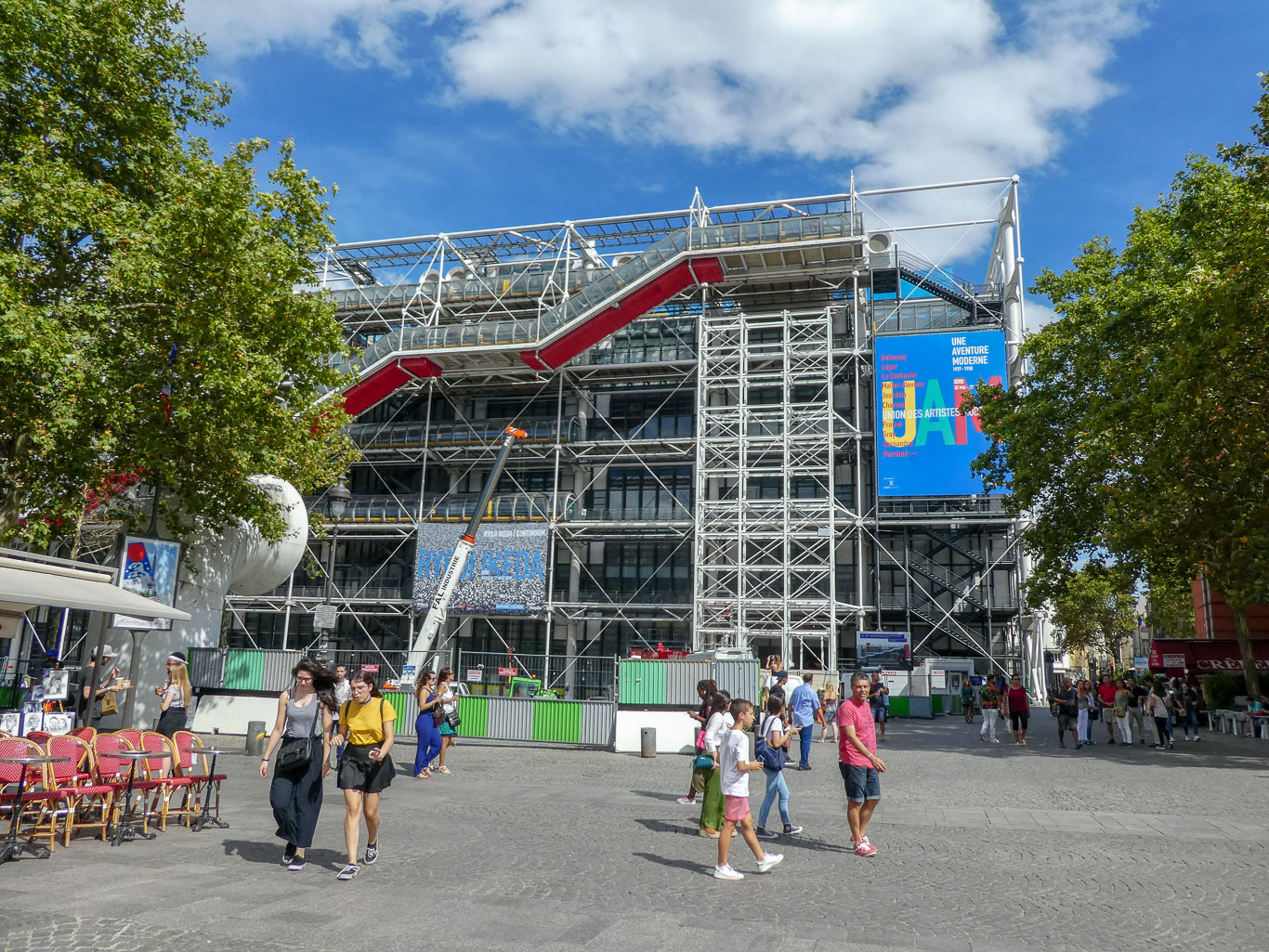
Once again we were really impressed by the helpfulness of locals when, on searching for a cooling drink but not knowing what to ask for, two young women helped us order the perfect drinks . . . (though I can’t remember what they’re called they were from Starbucks of all places and had berries floating on top – delicious). It’s also a good idea to ask for tap water, which the server in Starbucks happily gave us for free to top up our water bottles – definitely a win win!

Next to the Pompidou Centre is a collection of 16 mechanical sculptures that move about and squirt water. The idea came from the music of the composer Igor Stravinsky, which is why it’s called the Stravinsky Fountain. You can see the Firebird on the right of the photograph.
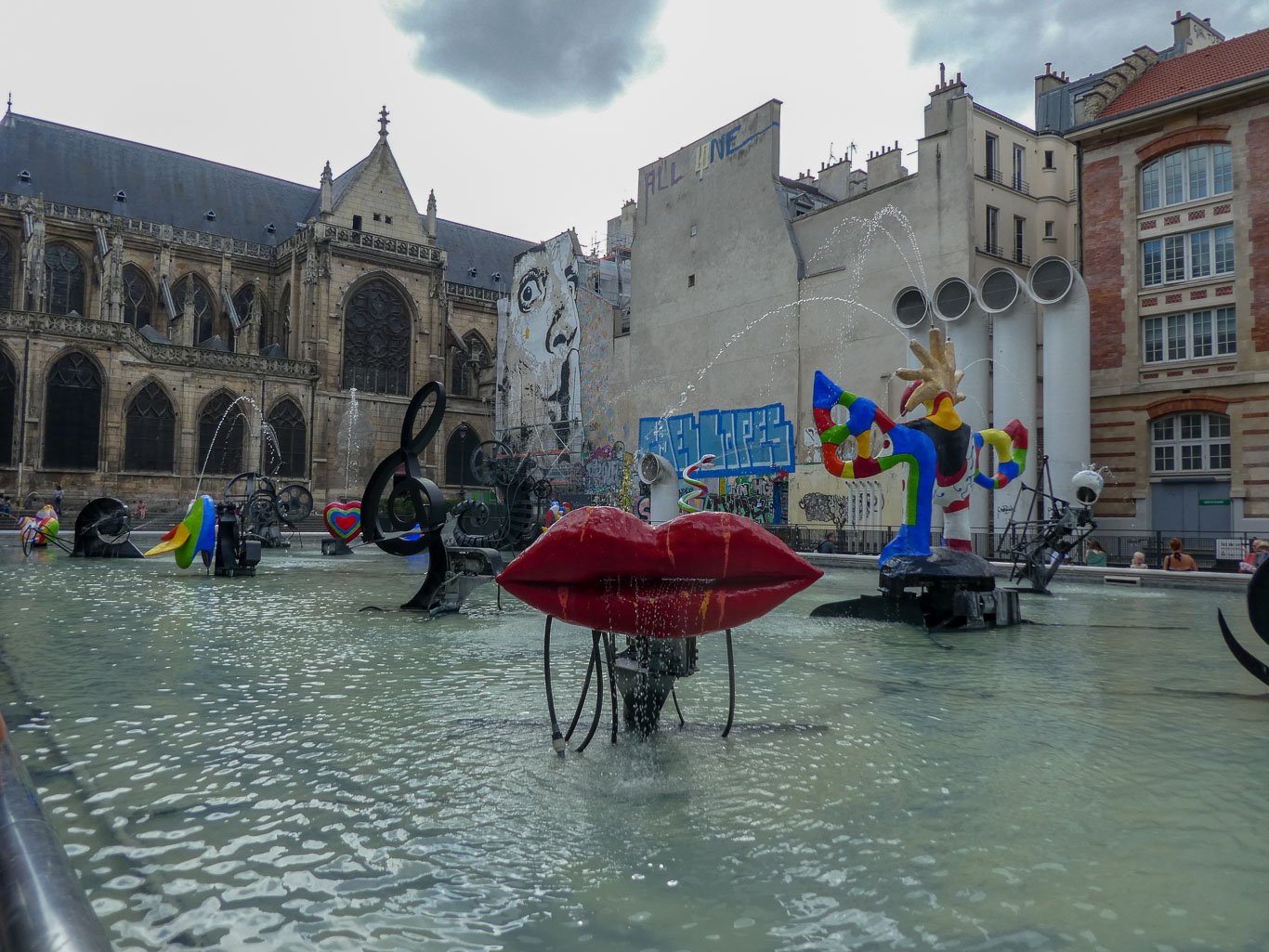

Paris with its colourful LGBT rainbows . . .
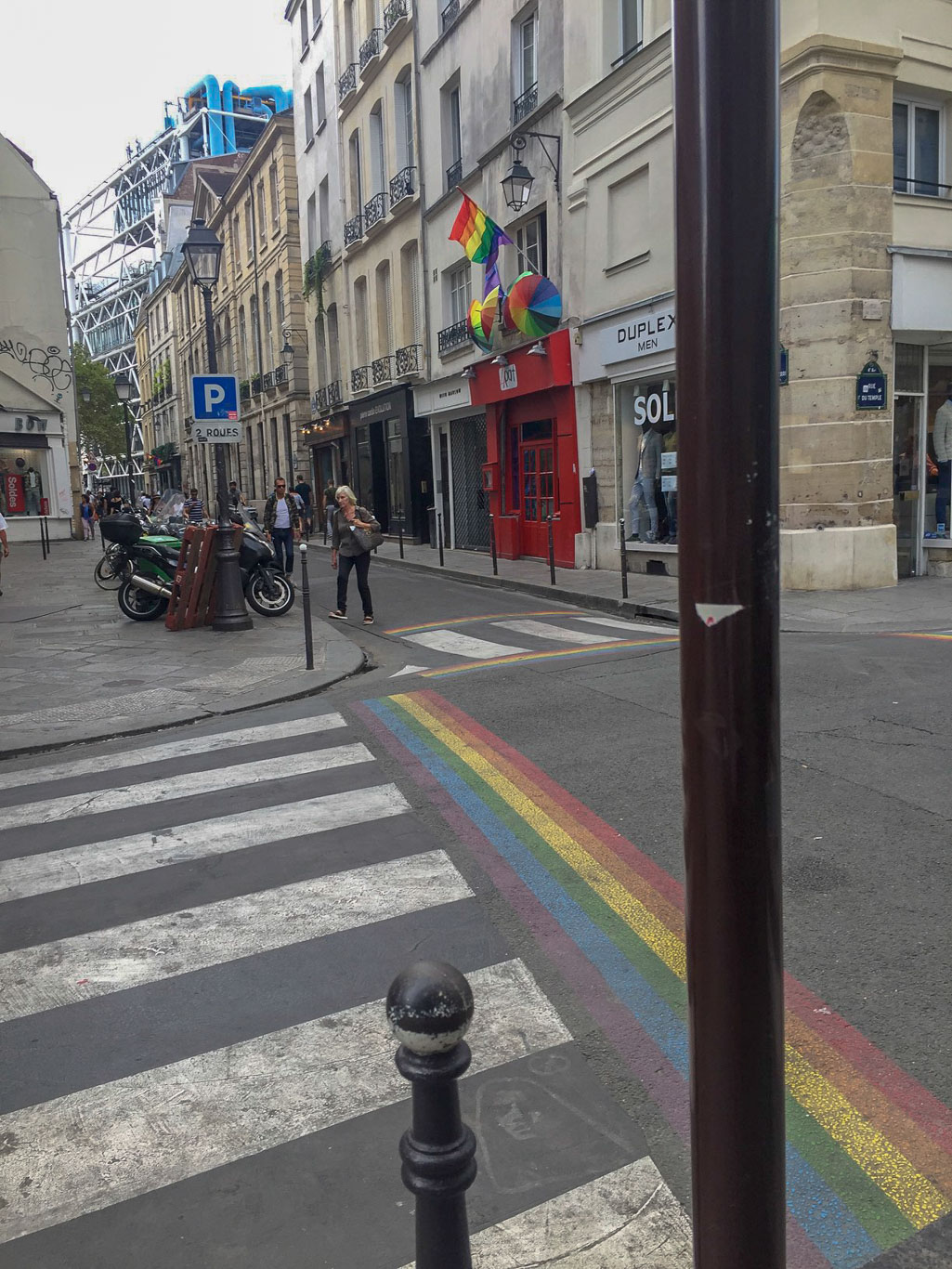
Now time to explore one of the many bridges across the Seine . . P1020309 & 11

. . . and our first glimpse of the famous Notre Dame as featured in the novel ‘The Hunchback of Notre Dame’ by Victor Hugo, the legend of the cathedral’s bell-ringer, Quasimodo.

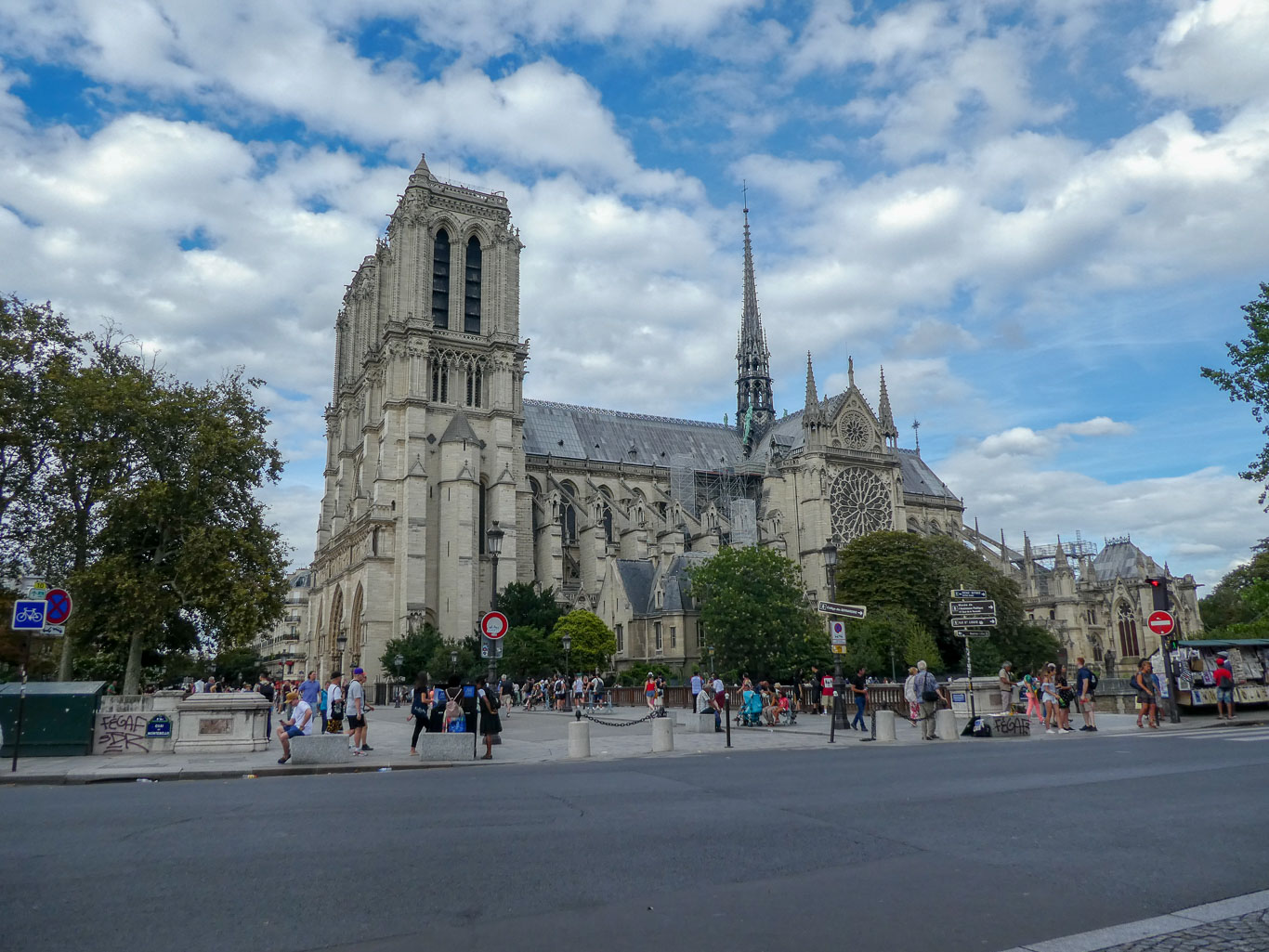
We had planned to visit the Paris Catacombs, hoping that at the end of the day the queues would be more reasonable . . . and ended up walking all the way there . . . and after waiting about an hour and a half they shut and we were still quite a way from the entrance . . . very disappointing! So after 13 or so miles of walking it was time to admit defeat and get the metro back to our hotel. Being worn out and on a budget Mila was very happy that we opted for MacDonalds for supper . . . well, sometimes it’s just easy!
Wednesday 1st August – The Catacombs – Viaduct Walk – The Louvre and exploring!
After much debate as to when to visit the Catacombs it was decided that an early visit would be best. It worked out perfectly. We arrived around 8.30am at the metro stop, Denfert-Rochereau and the entrance to the Catacombs is just across the street. There were only about ten other people waiting but by 9.30am there was a huge queue so it was a wise move to arrive early. I can imagine that it could be frustrating if you queued for hours to find that tour groups and those with tickets get in before you and with the number of visitors to the site limited to 200 which can delay admission it could easily lead to disappointment. Having read it was definitely easier just to buy the tickets once you got in. We didn’t have to pay for Mila because she’s under 18, our tickets were €13 and we did buy the audio guide €5 which was well worth it. We were in by 10.08am, not bad! The advantage of them limiting access is that the Catacombs were very quiet so you had time to really look and experience the atmosphere as the route took you further and further underground. The Catacombs are tunnels filled with bones of six million people whose bones were moved to these abandoned quarries about two hundred years ago because the cemeteries in which they had been buried were so overcrowded causing bad smells and the spread of disease. From 1786, and for the next 70 years, the bones were moved at night in carts covered with black cloth. At the entrance to the ossuary is a sign that reads, “ARRETE! C’EST ICI L’EMPIRE DE LA MORT” (“Stop! Here is the empire of death”).
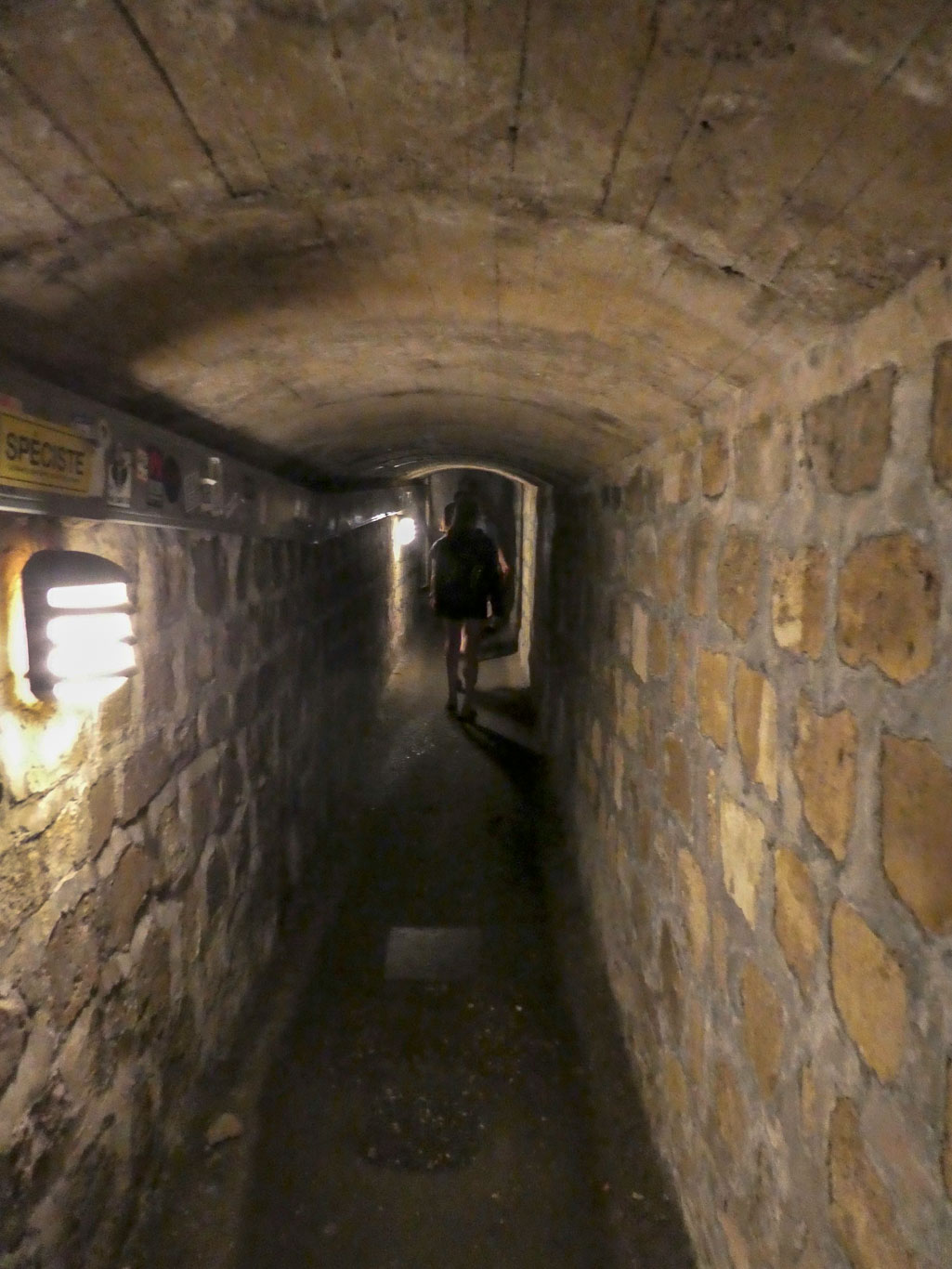
Before electric lighting was added visitors had to follow the black line on the roof to prevent them getting lost.

Crossroads with the lower Catacombs.
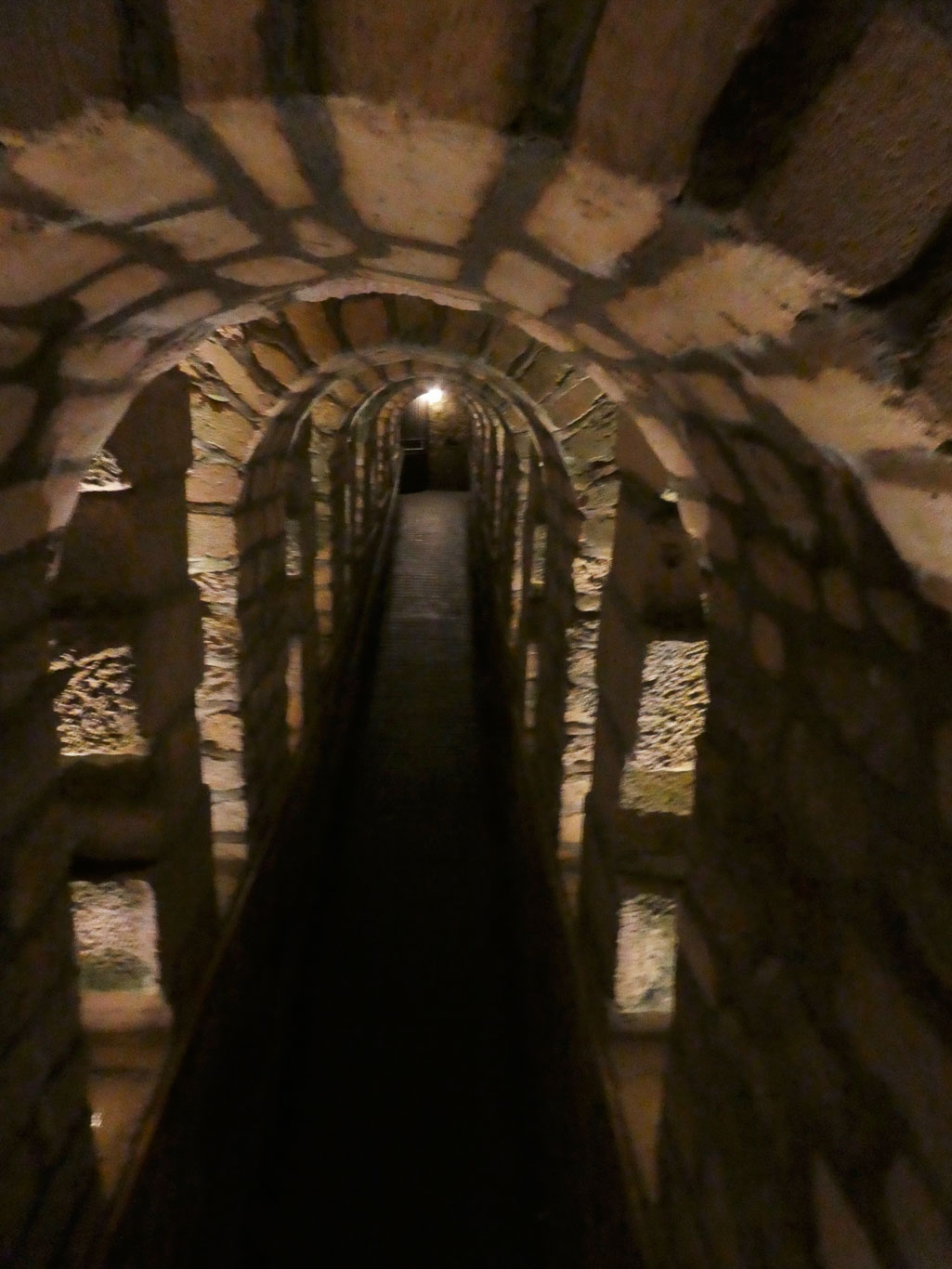
At first the bones were just thrown into an abandoned quarry shaft haphazardly but around 1810 Héricard de Thury, Inspector General of the Quarries developed this area. The long bones and skulls were arranged decoratively to form a back wall (called ‘hagues‘) behind which the other bones were piled.
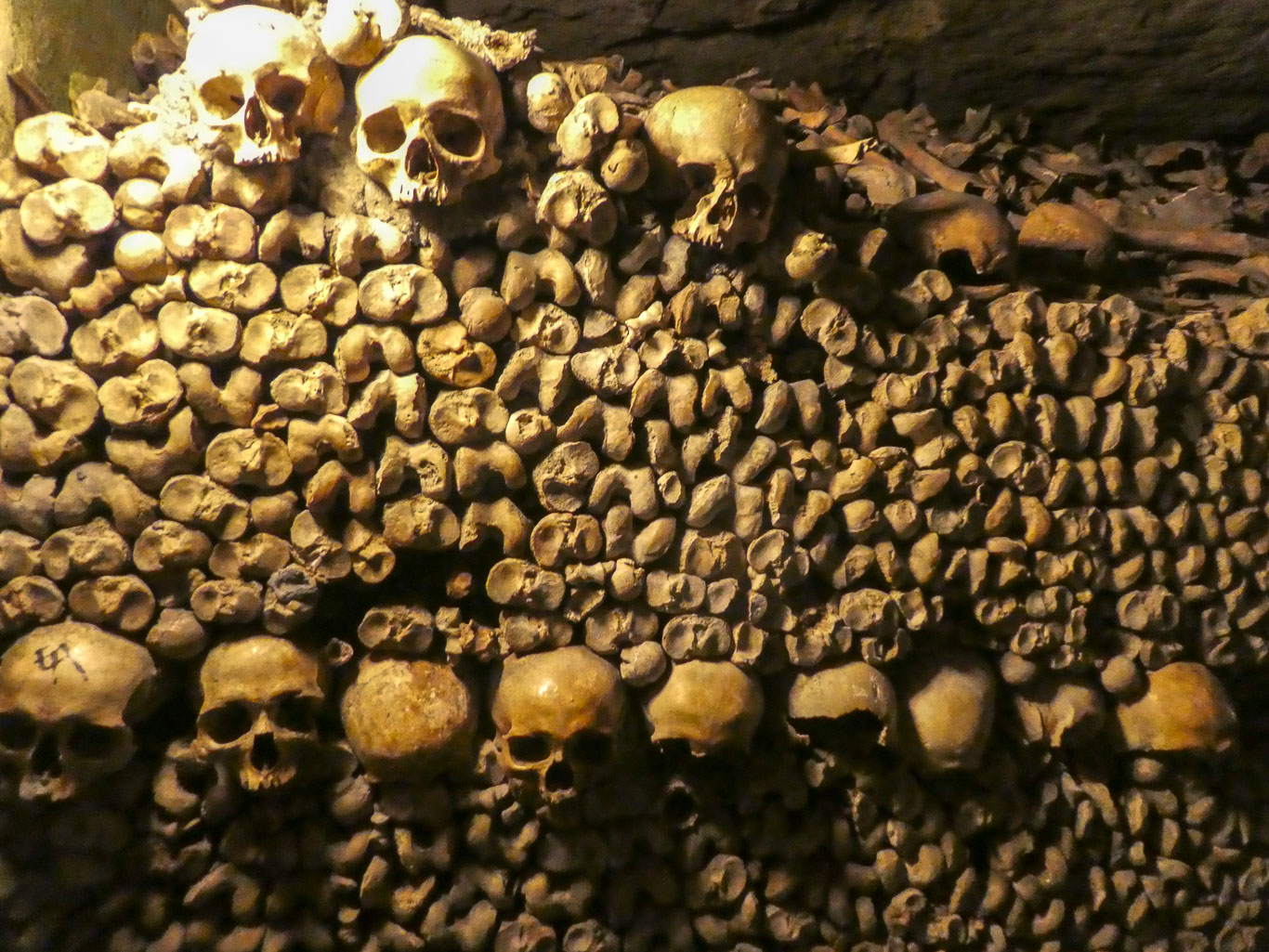
The skulls are even arranged as a heart here . . .

The decorative arrangement of the bones is in keeping with the medieval ossuary tradition. The guide notes tell us that along with a few lines reflecting on the fragility of human life, the overall impression is one of a strong sense of respect, meditation and fear.


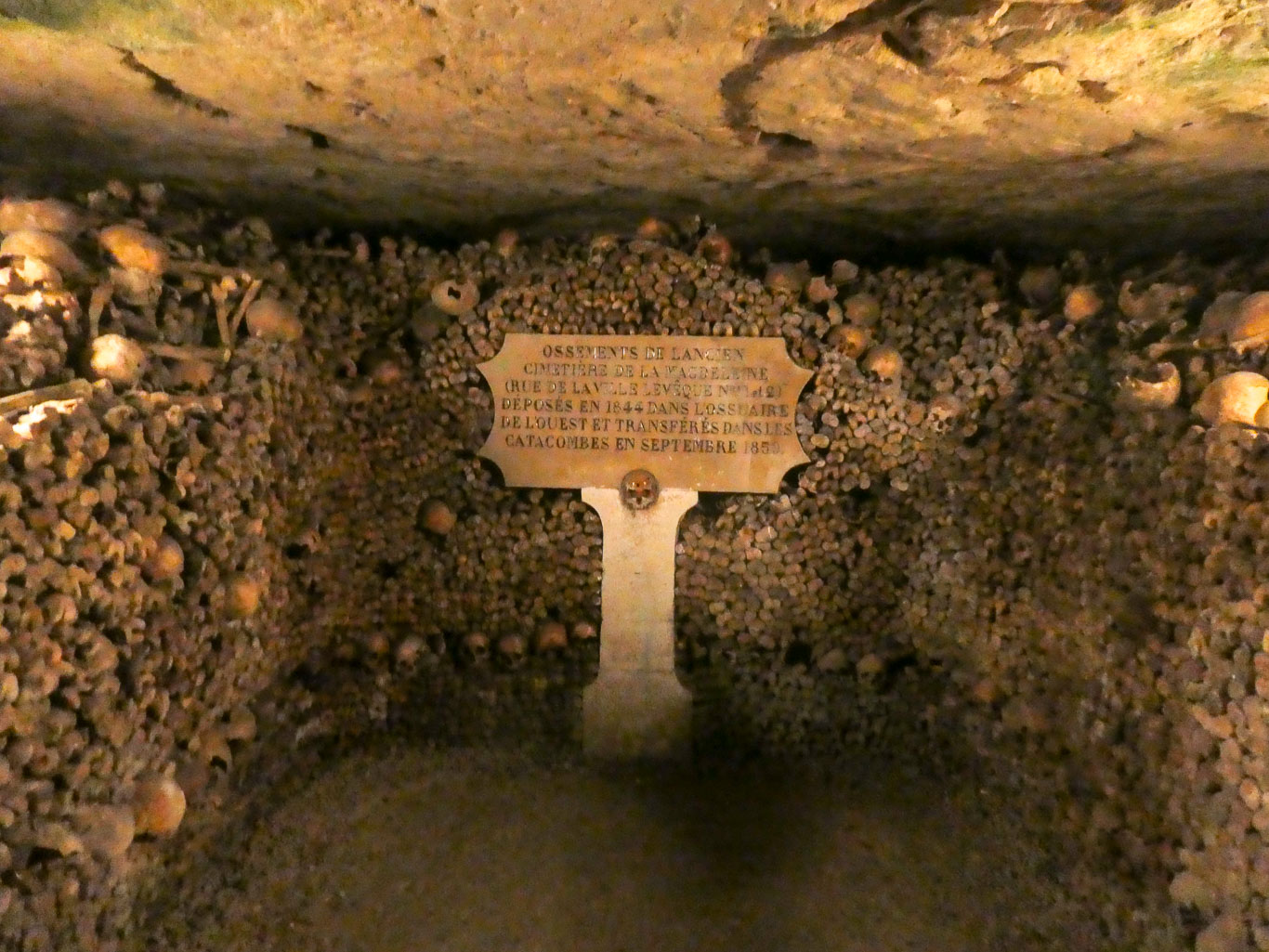
On the left side of the next photograph is the fountain of the ‘Samaritaine’, (of the Samaritan woman). It is in fact a well, around which are the bones from the Innocents’ Cemetery.
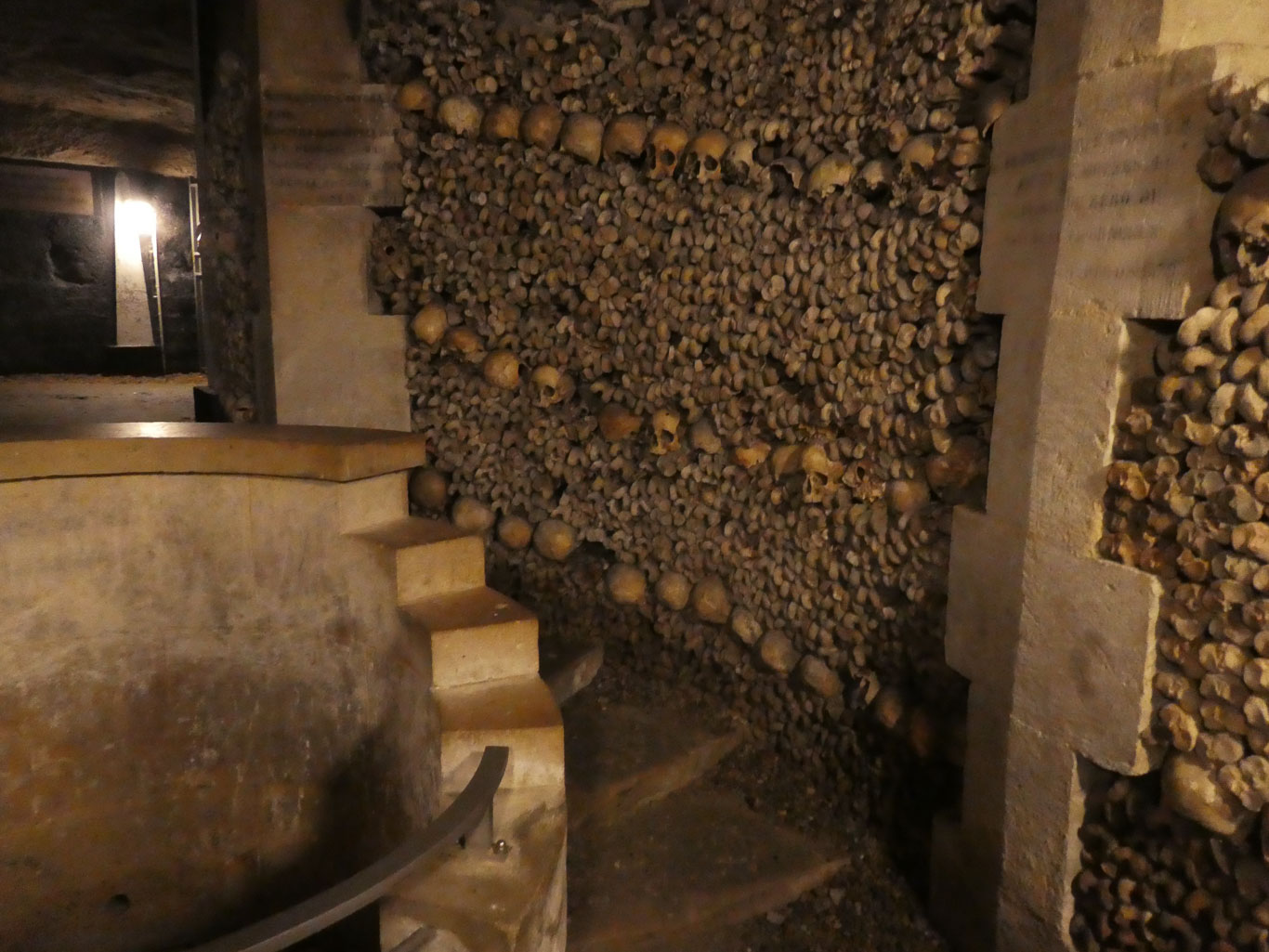
The next photograph show the area known as the Crypt of the Passion, with the ‘The Barrel’, which is a supporting pillar hidden by skulls and tibias that form a barrel shape. On 2nd April 1897, a night concert was organised here between midnight and 2am. The guide notes tell us that the information was circulated in the newspaper and over hundred people came to hear Chopin’s ‘Funeral March’ and the ‘Danse Macabre’ by Saint-Saens, among other pieces played by an orchestra of about fourteen players.
 During World War II the tunnels were used by members of the French Resistance as a hiding place from the Germans.
During World War II the tunnels were used by members of the French Resistance as a hiding place from the Germans.
An hour or so later and we were out into the sunshine once more. From here we headed off to the Gare de Lyon outside of which we found a perfect little cafe for some lunch which we ate outside before heading off to find the Viaduct Walk, the ‘Promenade Plantée‘; which has its starting point at the cross roads of Rue de Lyon and Avenue Daumesnil.

Mila bought a mini Rubik Cube yesterday and she’s determined to solve it, so while Catherine and I enjoy the views . .
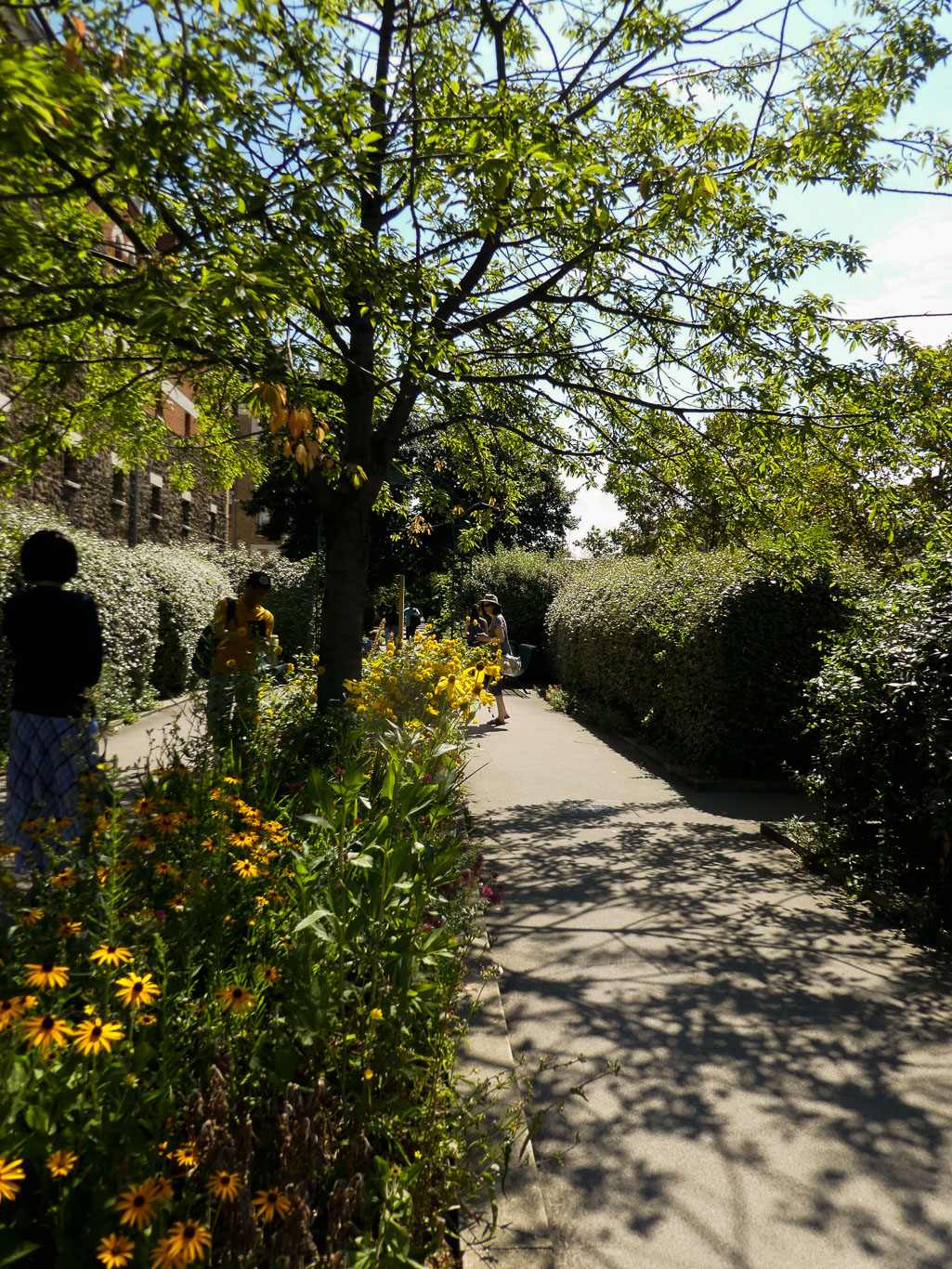 . . . Mila takes a little rest and uses the opportunity to try to solve her puzzle.
. . . Mila takes a little rest and uses the opportunity to try to solve her puzzle.

We also took the opportunity to admire some of the art work and cafes below the viaduct’s 60 brick arches . . .

. . . before returning to the Viaduct Walk once more. The shallow pools that you can see in the Guardian article linked to the ‘Promenade Plantée’ above have all been covered with wooden planks which was a shame but didn’t spoil the walk. Maybe they remove them in the spring? Anyway its well worth visiting at different times to see all the different flowers in different seasons.
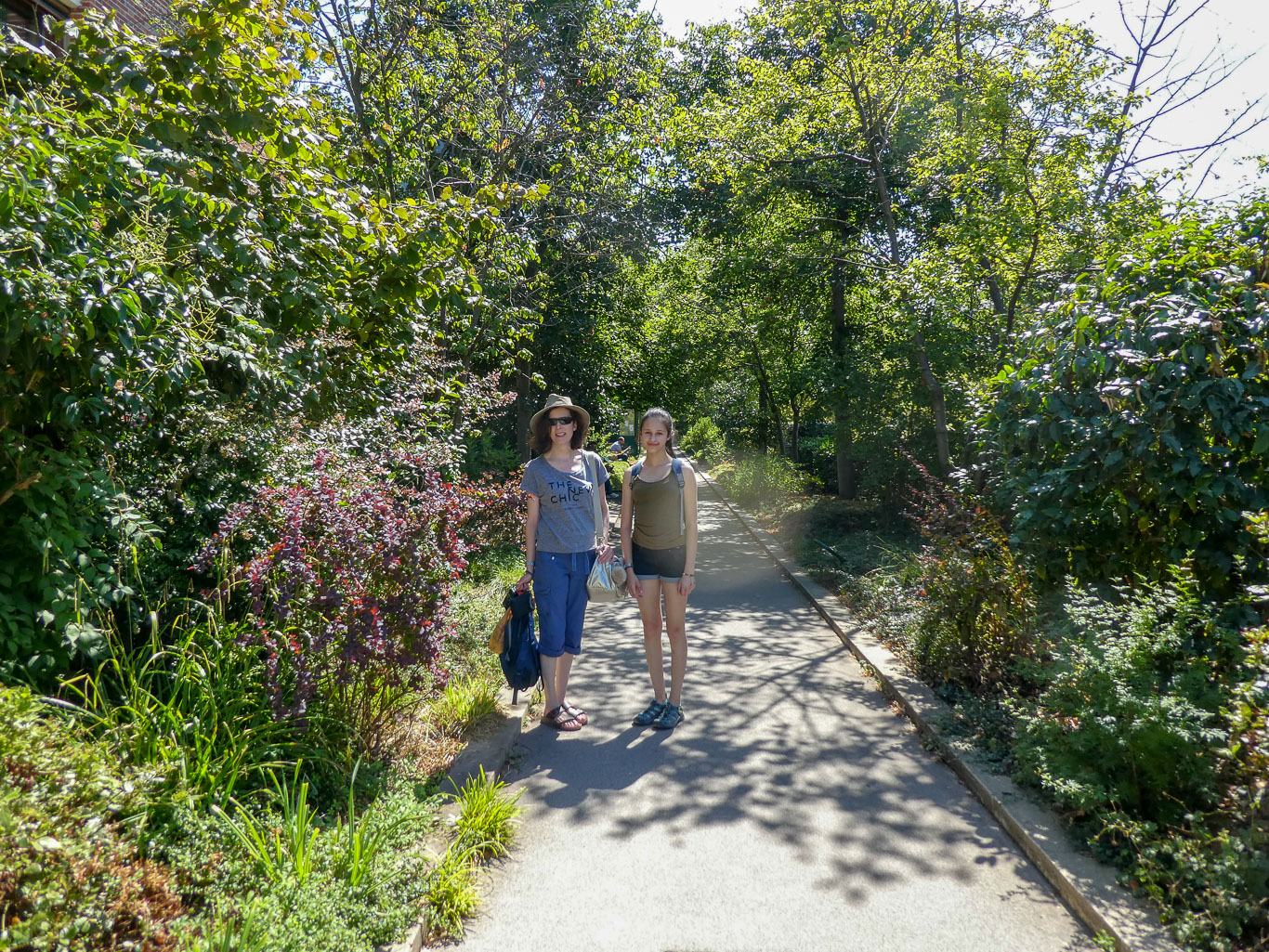
At the end of the Viaduct Walk it’s not far to explore the Bastille area. Nothing remains of the Bastille, the state prison that was stormed in 1789 at the outbreak of the French Revolution. The monument commemorating the revolution of 1830 stands in the centre of the Place de la Bastille and is known as the ‘Colonne de Juillet‘ (the July Column). The statue on top is Auguste Dumont’s ‘Genie de la Liberté’ (the “Spirit of Freedom”), brandishing the torch of civilisation and the remains of his broken chains.

The Bastille area was a hubbub of busy cafes and tourist shops, very interesting but on a hot day we preferred the calmness of the river Seine and its bridges . . .

As we were investigating our map looking for nothing in particular, just getting our bearings a really kind local man took time out to show us one of the best places to photograph Notre Dame and told us several areas which were worth exploring, he lived nearby and couldn’t have been kinder. There’s Mila and I with Notre Dame behind us (shame about the scaffolding on the cathedral!).

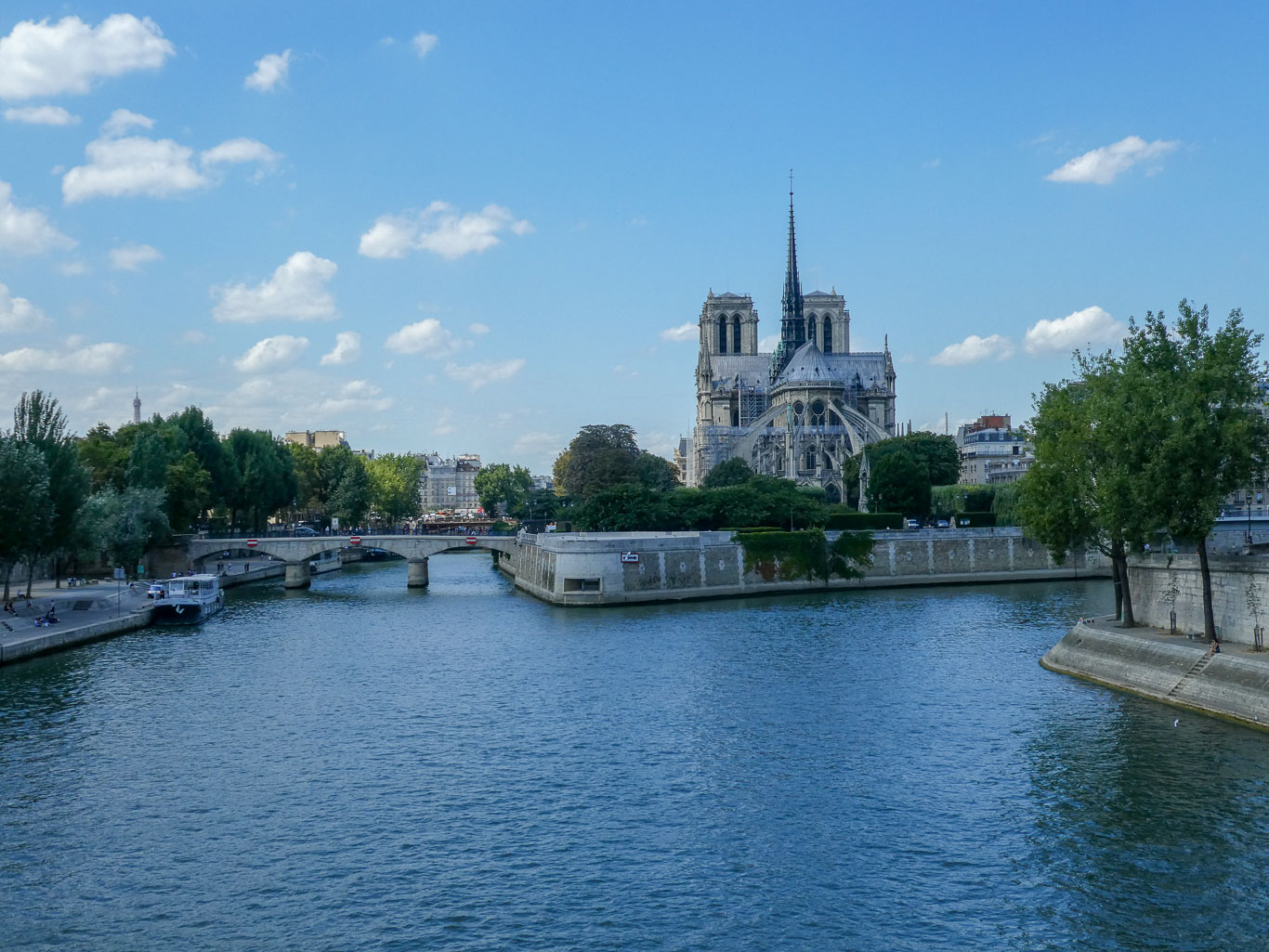
Now exploring the shops along the centre of the smaller of the two islands in the Seine, Ile St-Louis, we couldn’t resist the delicious sorbets on offer.
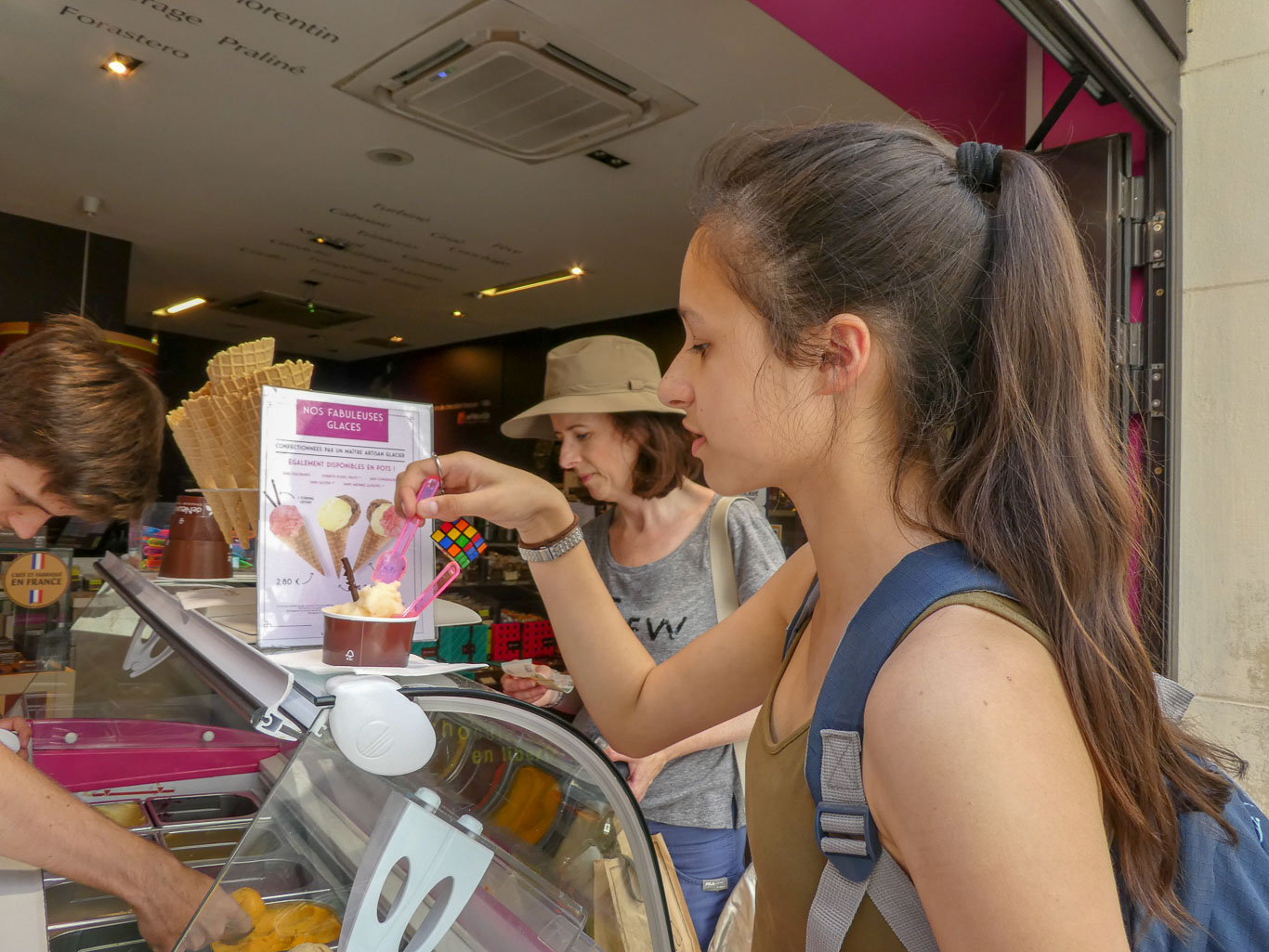
. . . the shops looked beautiful too . . .

Later walking along one of the areas recommended to us we saw this shop . . .

. . . and couldn’t resist buying one of their speciality brioche loaves made with raspberries and sugared almonds . . . This mixture is then kneaded into the loaf so the nutty texture is throughout. We got a bit carried away and bought a chocolate chip brioche loaf too. Amazingly they survived till we got home and they were still delicious!

Back to the Pompidou Centre, which was open this time!
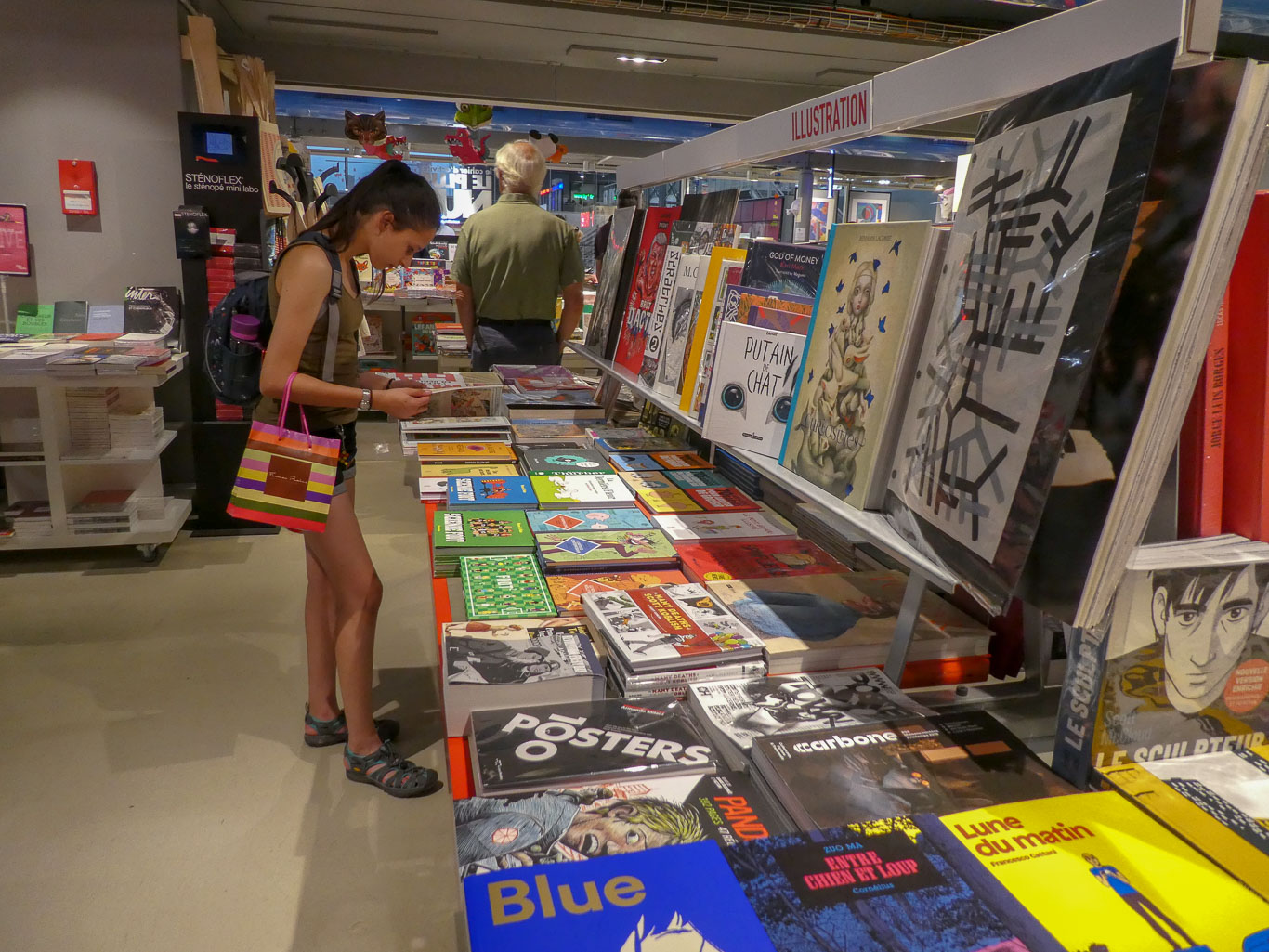
Then time to visit another of the areas suggested to us, crossing by the bridge leading to the Quai De L’Horloge.
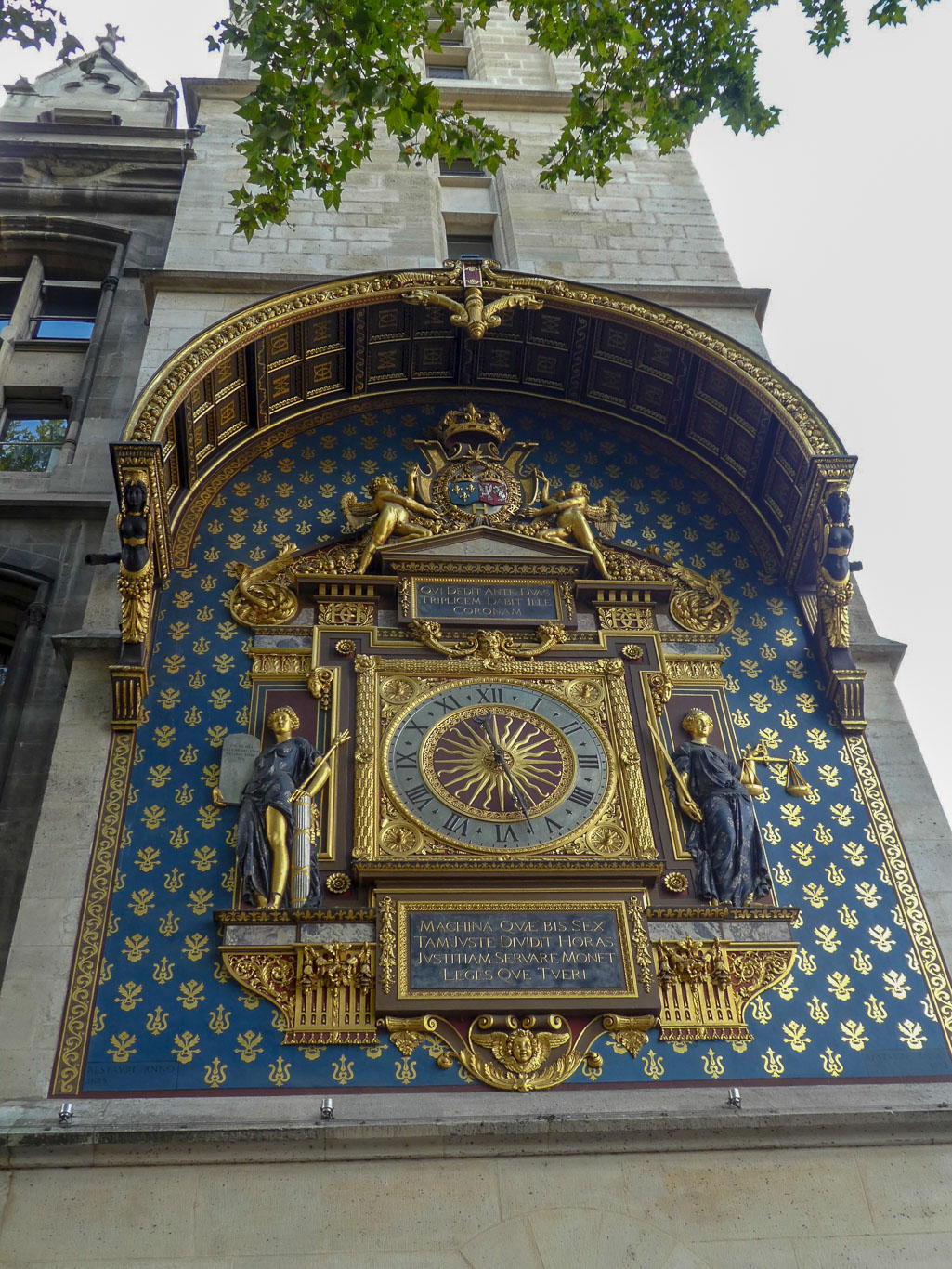
Now in the Saint Germain area . . .

. . . and finally our first cup of tea this holiday! Served with waffles with cream and nutella – Mila’s choice but very yummy. It was lovely just to sit and watch the world go by, perfect.

As we were walking back towards the Louvre we passed some really interesting art work . . .

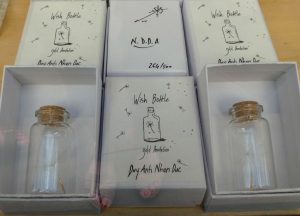
Lovely idea of a wish in a bottle but a hefty price tag of €60 seemed a bit over the top.
About to cross another bridge, we’re all a bit weary now. Crossing Pont Royal, which takes you back to the Louvre.

Notice the padlocks around the lamp post, a symbol of enduring love . . .so romantic

Spectacular views
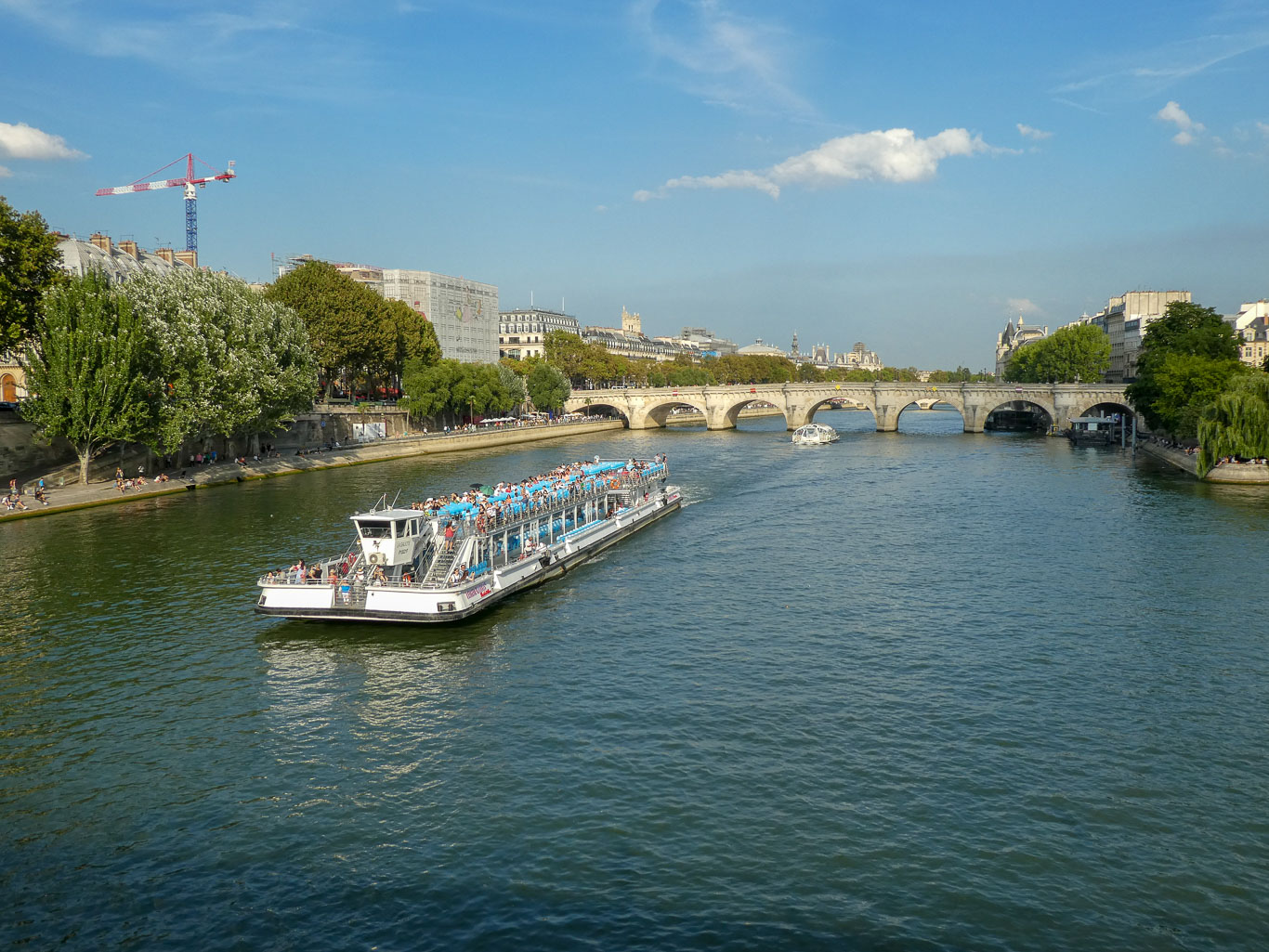

As we entered the Louvre area a Cellist played the most beautiful music, the acoustics making the music reverberate around the walls, wonderfully atmospheric.
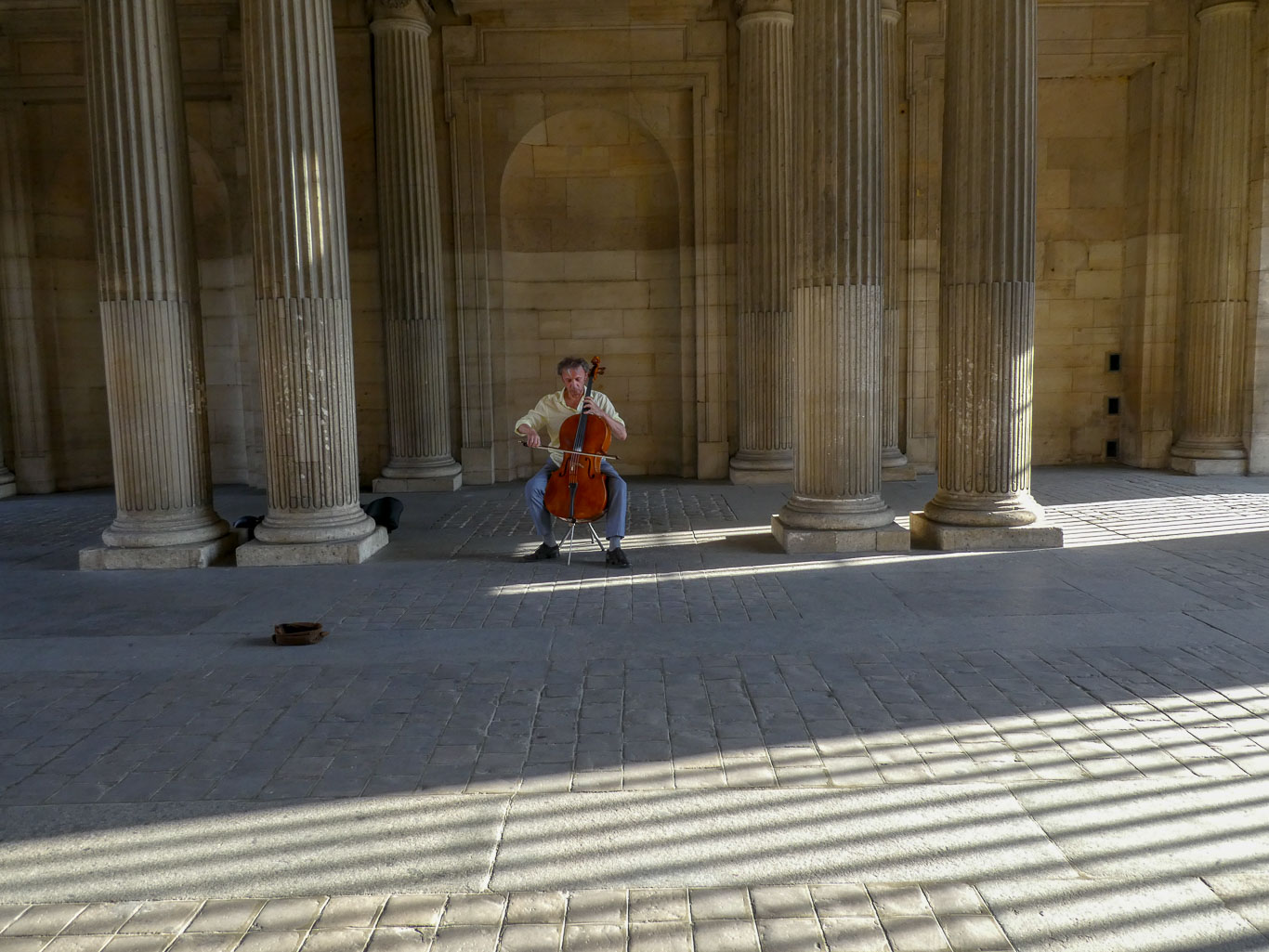
By this point it was about 6.30pm the air was cooler and to our surprise we realised that museum had a late night opening till 9.45pm, an opportunity too good to miss, and no queues to get in!

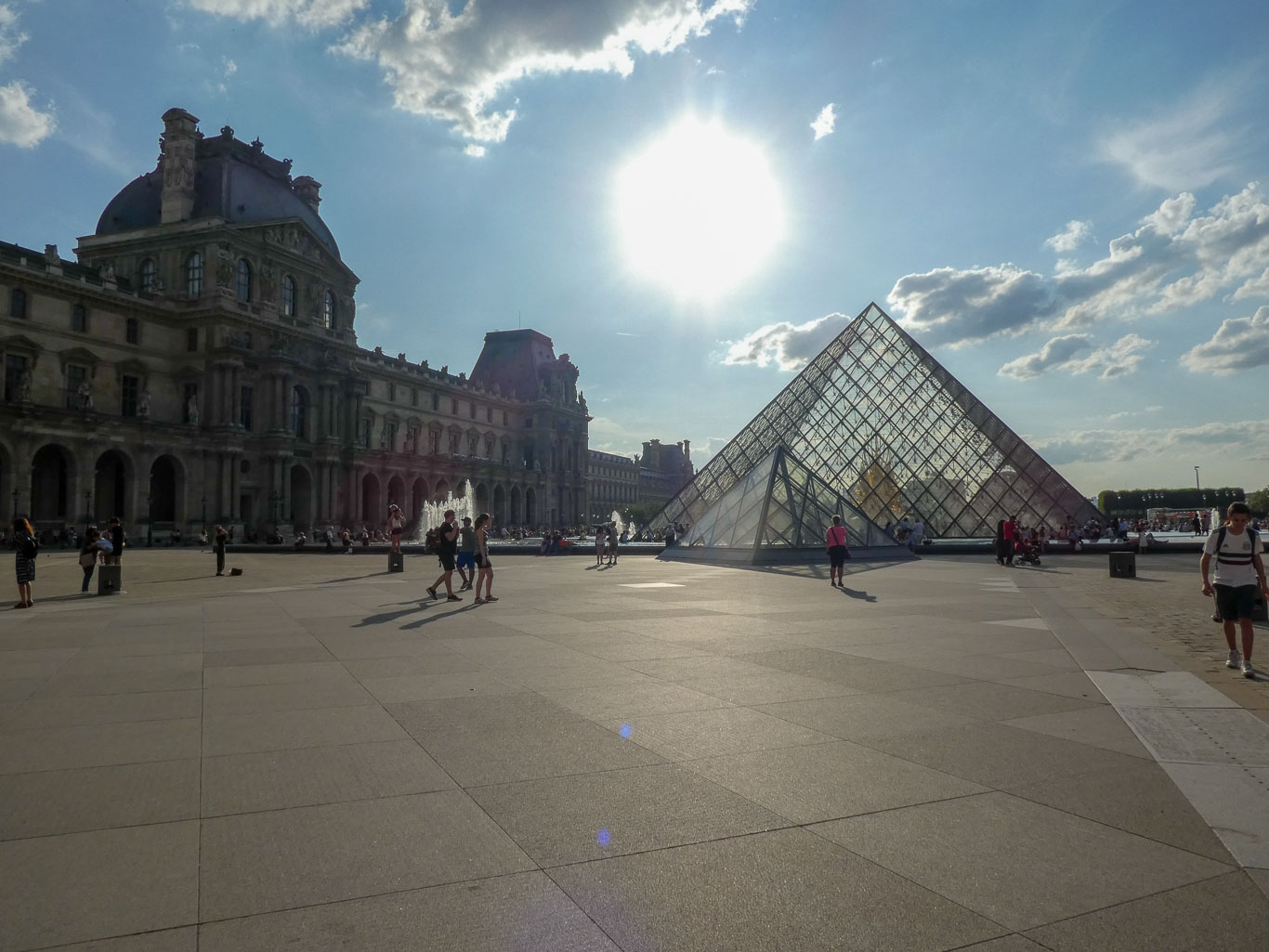
This is a photo of Mila and I just inside the entrance with the huge golden sculpture called ‘Throne’ by the Japanese artist Kohei Nawa in the background. We were lucky to see it as it’s only on display from July 2018 until January 2019. It’s a floating vacant throne as the leaflet we were given explains. It’s meant to be “an expression of the artist’s prediction that information technology and artificial intelligence will eventually replace “absolute power.” The inspiration for the throne came from the floats often found in religious Asian ceremonies and festivals.”
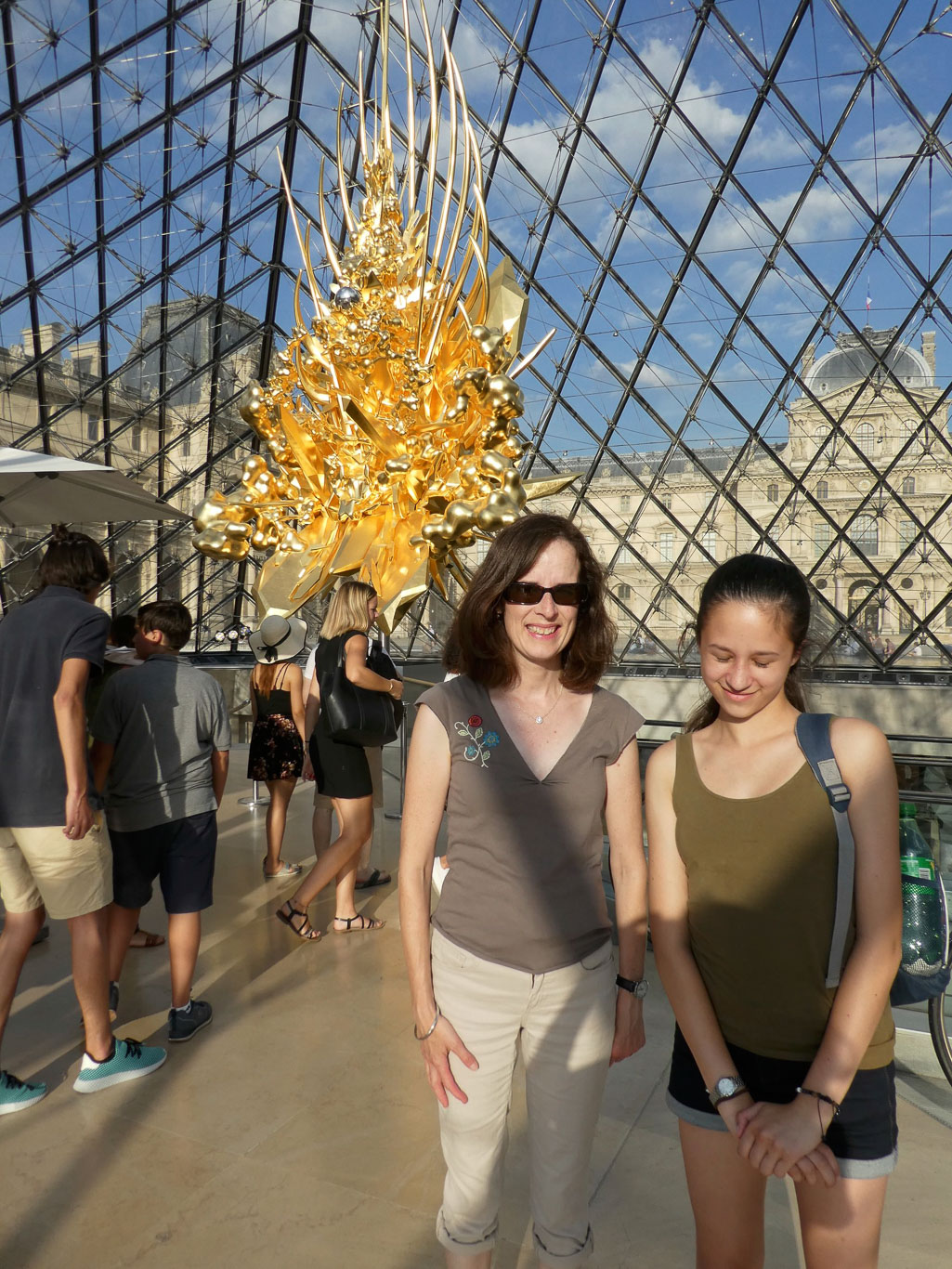
 We opted for the audio guides but they ended up being quite complicated to use and with little time we all ended up abandoning them though if you had the whole day I think they could have been really useful. Mila wanted to explore by herself but finding that we had told Mila to wait at the exit at 9pm when the museum in fact closed at 9.45pm I spent the whole time trying to find Mila who wasn’t where she said she would be, grrrrr! It’s so vast it’s really easy to get lost even with the map and guide, but being so late meant that it was much quieter than usual. I only saw the Mono Lisa where there were still crowds otherwise I was often searching for Mila in vast and beautiful rooms.
We opted for the audio guides but they ended up being quite complicated to use and with little time we all ended up abandoning them though if you had the whole day I think they could have been really useful. Mila wanted to explore by herself but finding that we had told Mila to wait at the exit at 9pm when the museum in fact closed at 9.45pm I spent the whole time trying to find Mila who wasn’t where she said she would be, grrrrr! It’s so vast it’s really easy to get lost even with the map and guide, but being so late meant that it was much quieter than usual. I only saw the Mono Lisa where there were still crowds otherwise I was often searching for Mila in vast and beautiful rooms.

Doesn’t this statue look incredible, how has it survived, so undamaged for all of these years?
Such exquisite jewellery . . .
There are so many rooms in the Louvre that it’s impossible not to get lost. At this time of the day many of them were quiet so it gave me the chance just to enjoy the actual architecture of the rooms.
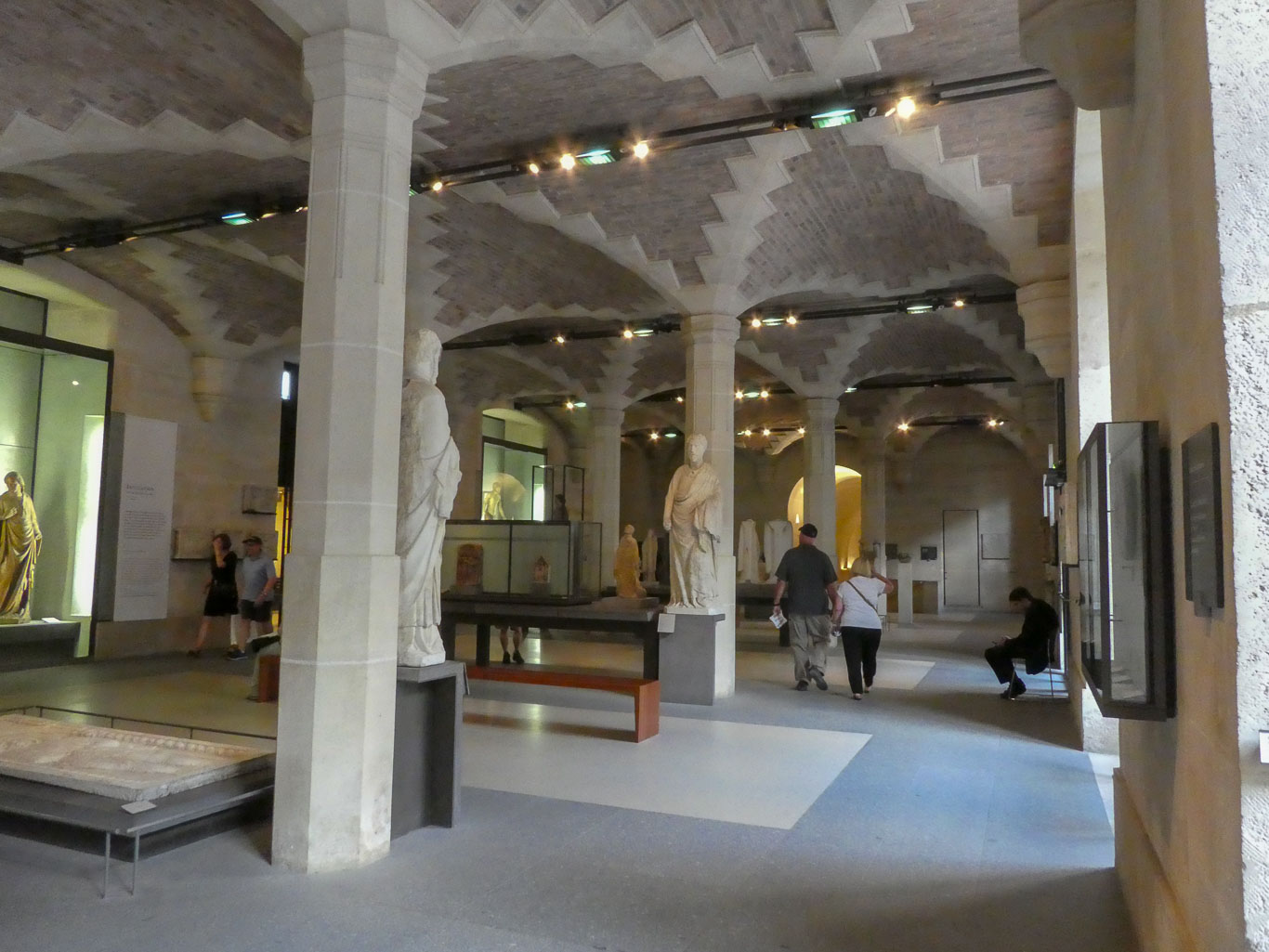
I thought these stairs were gorgeous . . . in fact many of the rooms themselves are beautiful, never mind the incredible exhibits!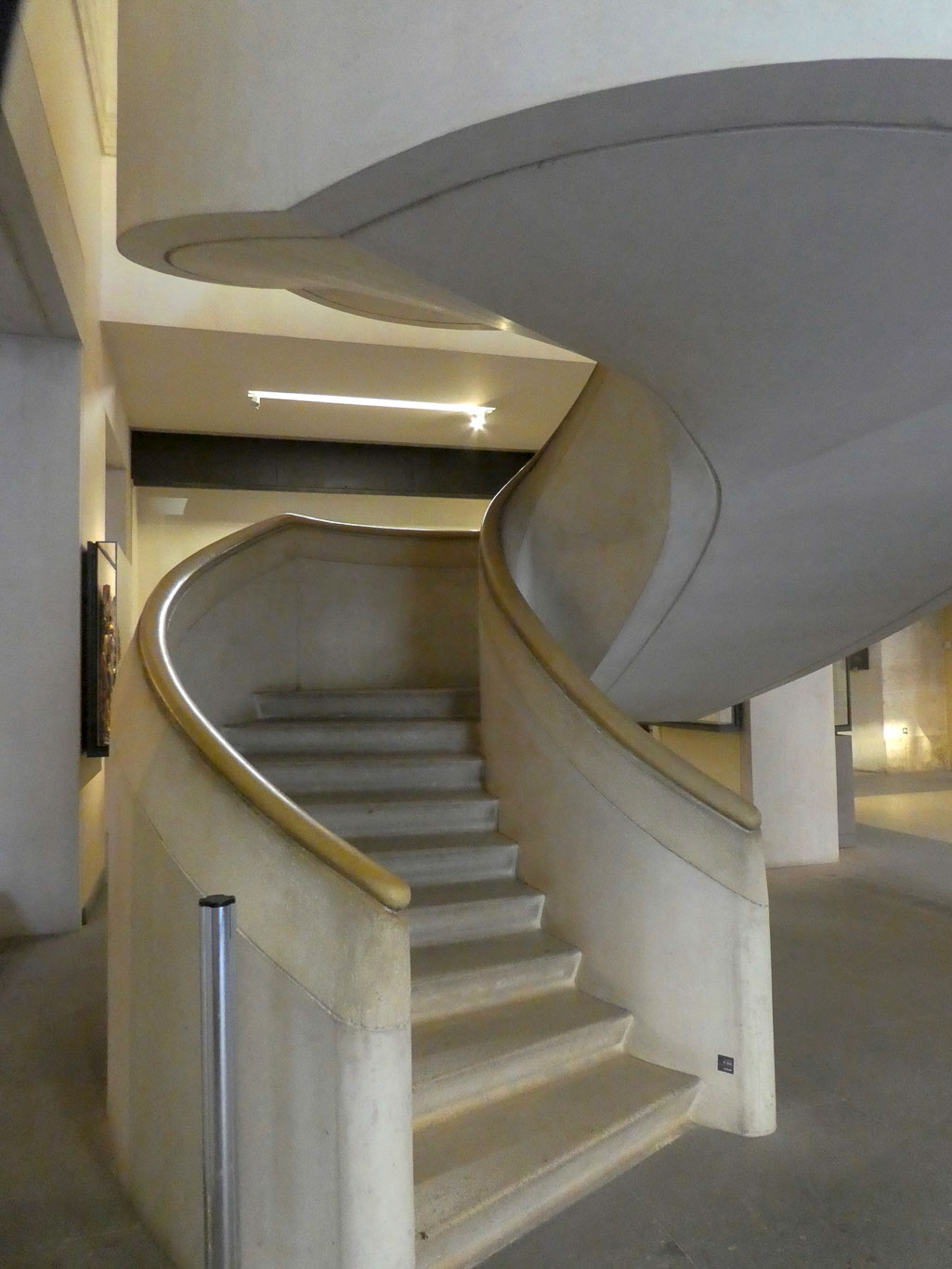
The label for this exhibit said that this is a Theban female idol shaped like a bell. It went on to explain that this figurine is part of a small group of ‘dolls’ with articulated legs, found for the most part n children’s tombs. The hollow body was made on a potter’s wheel, while the rest was modelled. The mobile legs, attached to the body by strings evoke the journey to the underworld. The painted patterns on the dress (aquatic birds, branches) may be a reference to the Mistress of Animals (Potnia Theron).

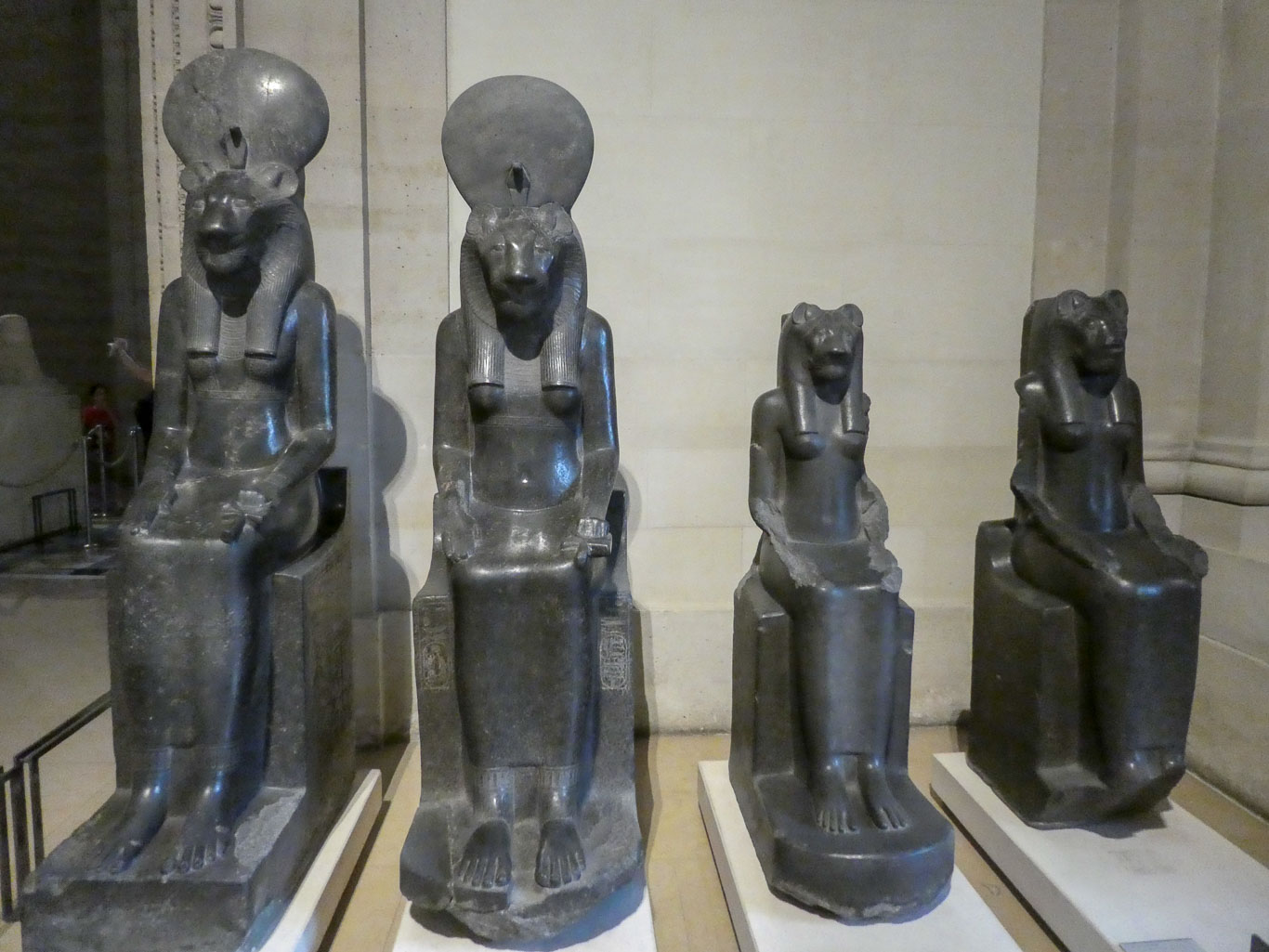
There are so many different levels and rooms to explore you could never do it all even if you had all day and we only had a few hours.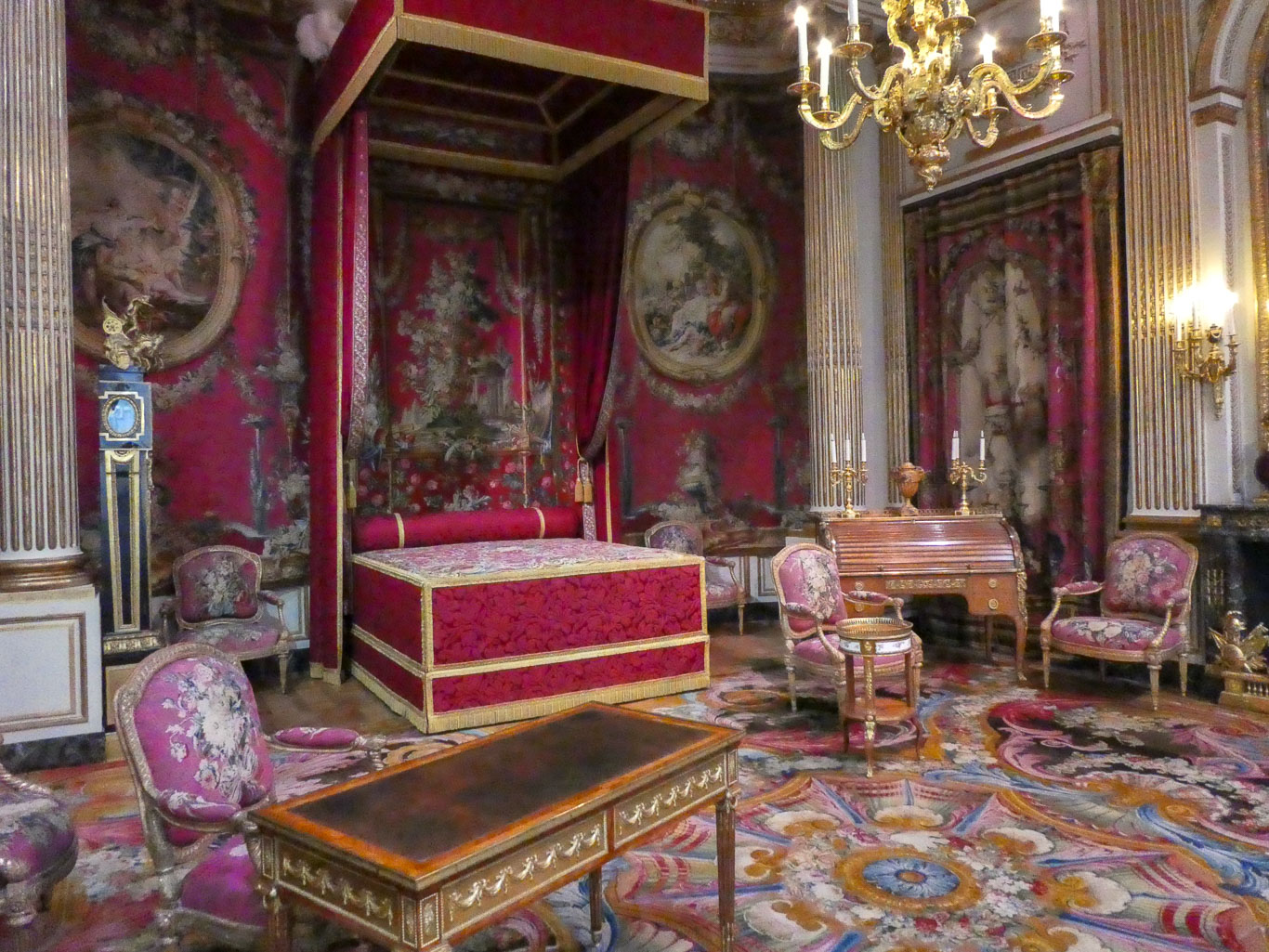
We all had a laugh at the sign as we left . . .

The long day was drawing to a close and it would probably have been a good idea to get the metro home, but then we would have missed out on some glorious sights as we walked through the Jardin des Tuileries with the fair ground rides on the left and saw the rise of the Champ-Élysées leading us up towards the Arc de Triomphe – Wow, such views were surly too good to miss, though more than 15 miles of walking was just a little excessive?
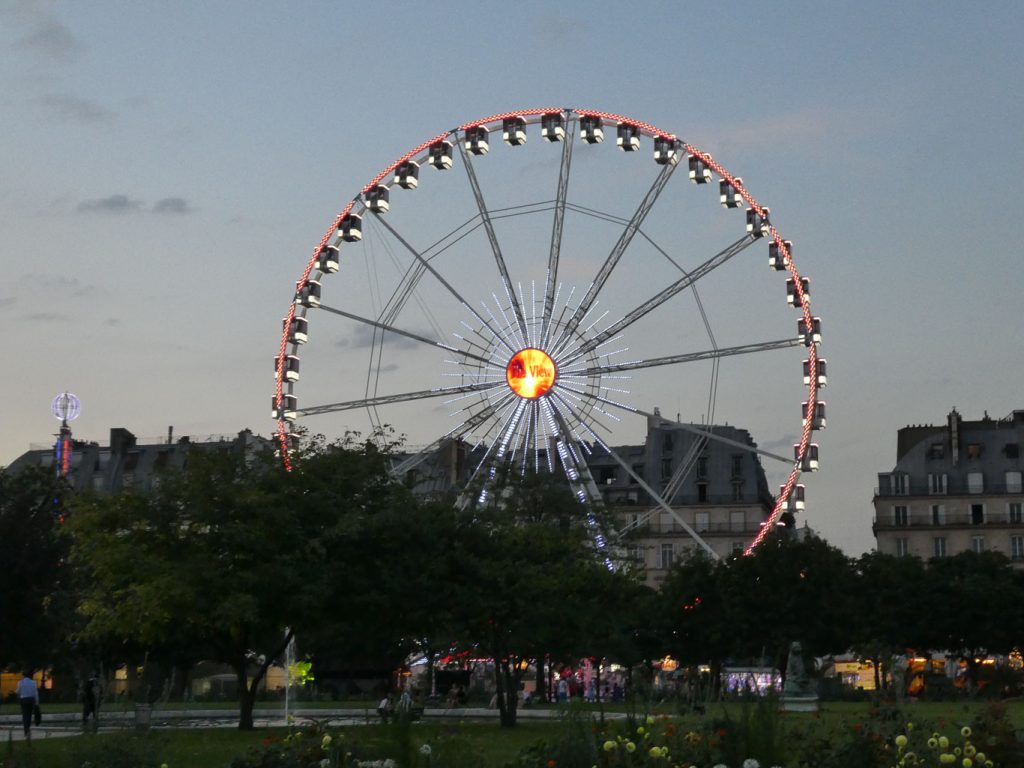

Then, not only did we see the Eiffel Tower lit up but it suddenly started to sparkle, so lovely to see.

Thursday 2nd August – Sacré-Coeur and Montmartre – then home!
After such a long day yesterday we took our time getting up only leaving the hotel about 10am. As we had wisely checked out the left luggage at Gard de Nord when we arrived it was easy to put all of our luggage in one large locker for €9.50, definitely worth it. We had to go across the road to the Metropolitan sign to get the train to Anvers for our visit to the Sacré-Coeur. Time for some breakfast before climbing the hill. Surprisingly the tourist shops around here were cheaper than around the Pompidou Centre, which is worth keeping in mind. By the time breakfast was over our metro ticket had expired so we didn’t go on the ‘Funiculaire de Montmartre’ the little cable car that takes you from the base of the church grounds to the entrance. But the weather was glorious and the view breath-taking so no one much minded.
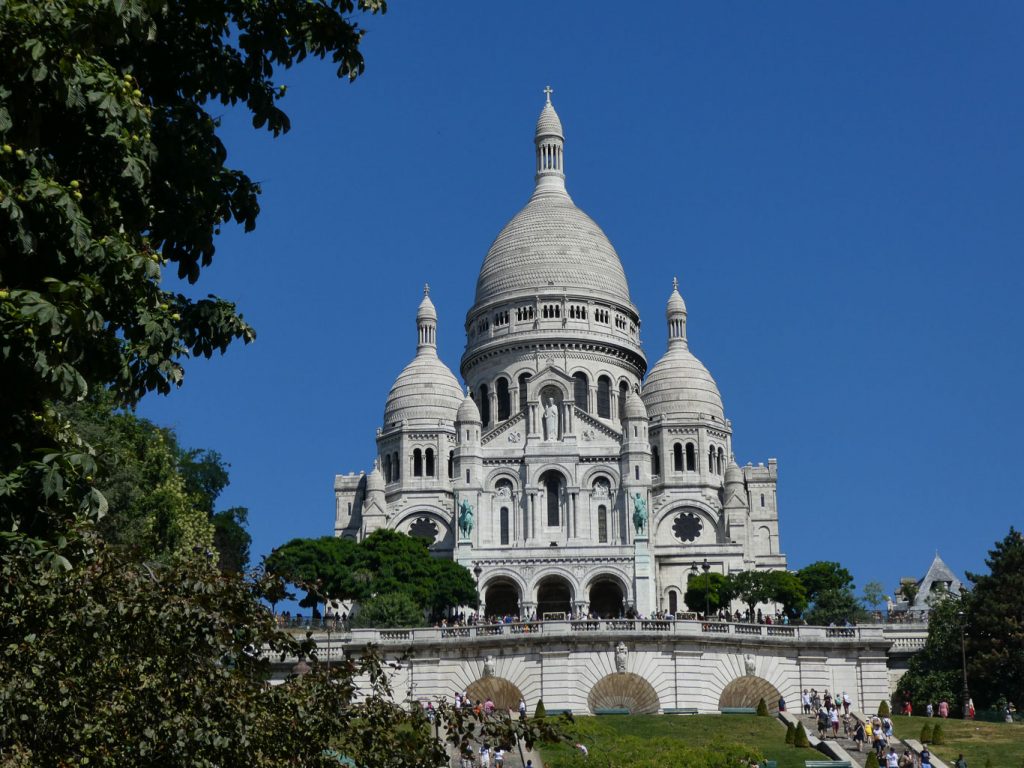
You may be wondering how the Basilica of Sacré-Coeur keeps so clean and maintains its brilliant white colour despite the polluted city air. . . well, whenever it rains on Montmartre Hill, the rain reacts with the limestone used to build the Basilica to secrete calcite, a mineral which acts like a bleach, amazing isn’t it?
 Looking down the steps over Paris.
Looking down the steps over Paris.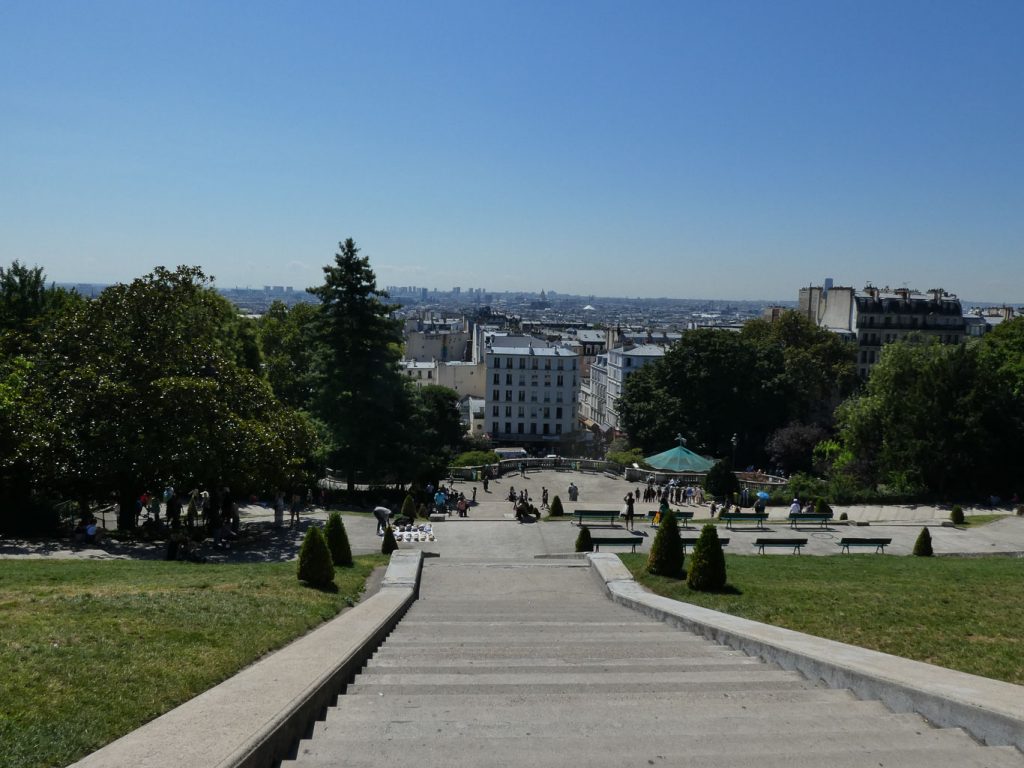
The stone statue of the Jesus, the Sacred Heart, blessing the town.

At the entrance to the Basilica are two bronze statues of French saints. Saint Joan of Arc led the French to victory in war while King Louis IX was sainted for being a kind and fair ruler. Below is a photo the statue on the left of the entrance of St Louis presenting Jesus’ crown of thorns.

Beautifully designed . . .

Inside the atmosphere was surprisingly reverent despite the hordes of visitors and inside the religious artwork and architecture took my breath away.
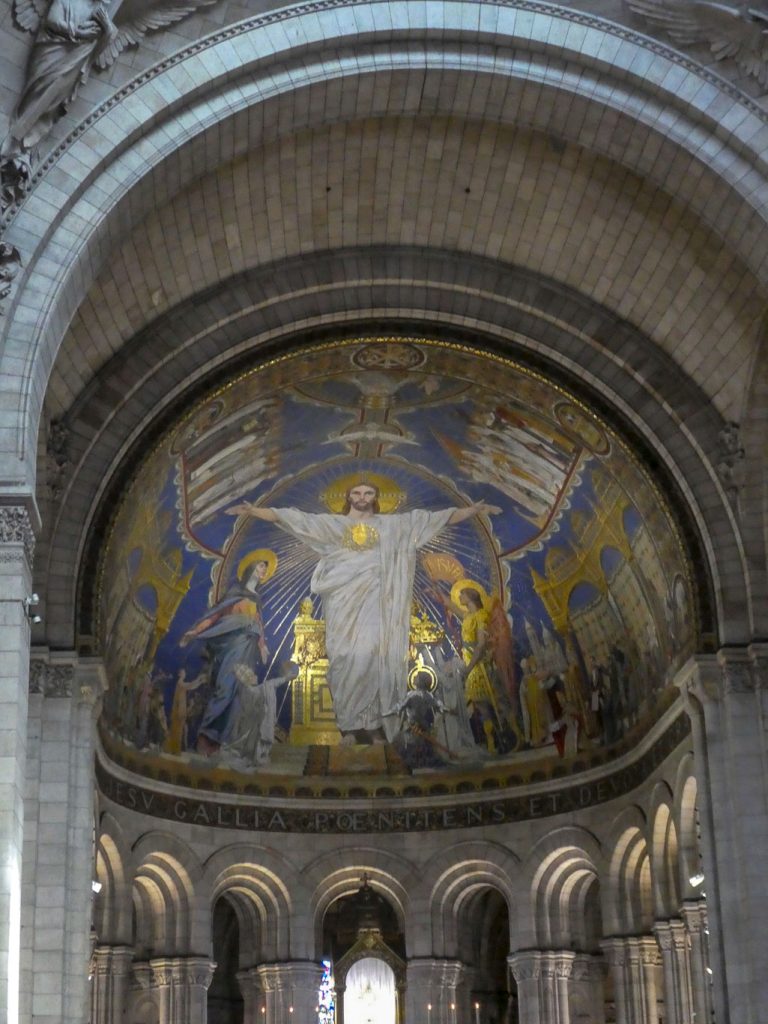
Incredible stained glass windows:
An intricate model of the Basilica, every detail seems to have been included.

More photos . . .
I can’t help but try and imagine what it must have been like to create such sacred paintings.

At the small altar dedicated to Mary I decided to light a candle and just say a little prayer, it just felt like the right thing to do . . .

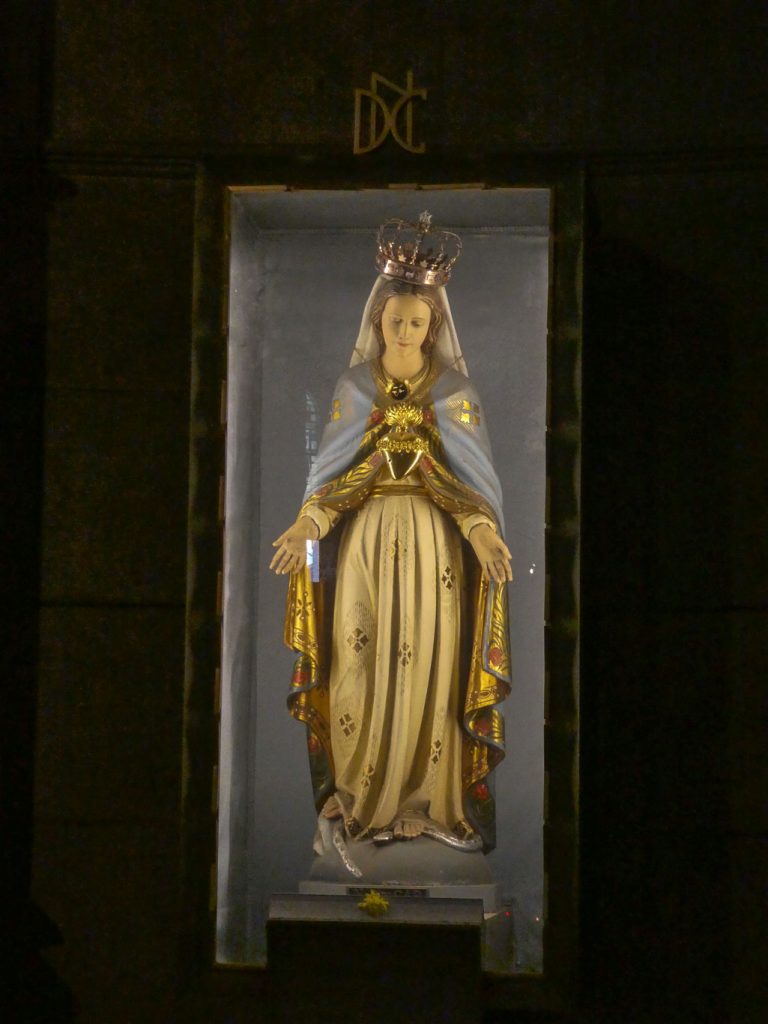

The eternal light of God

The photo below shows a private corridor off the main church, calm and tranquil, a place just to stop and think . . .
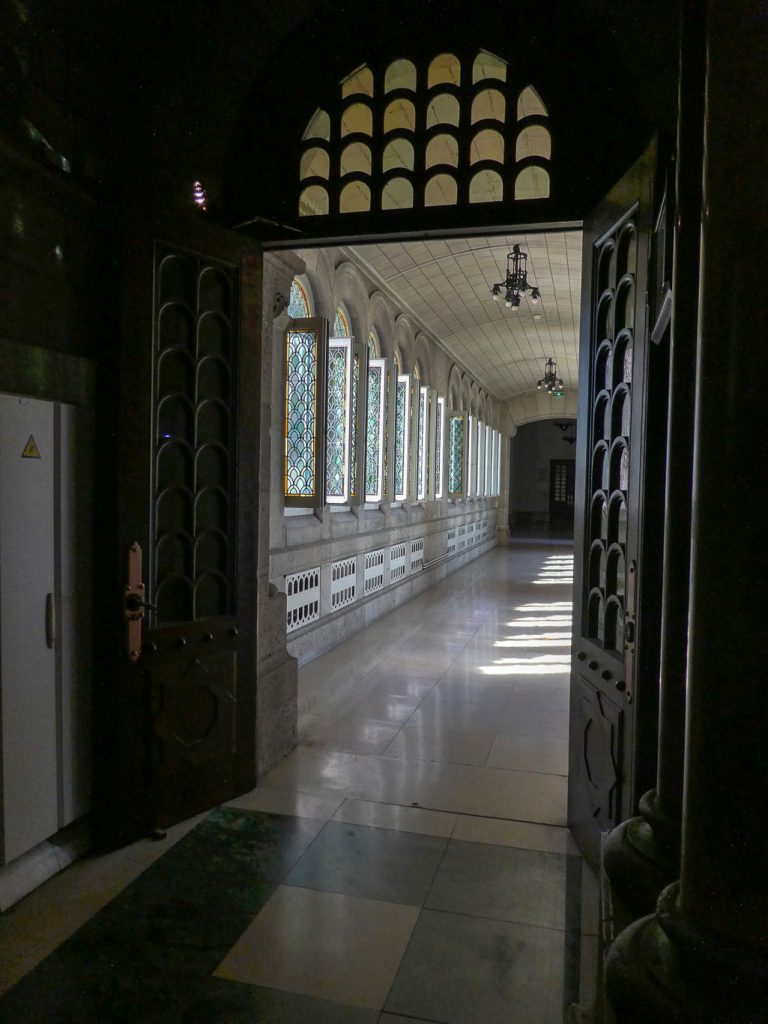
Almost time to leave now
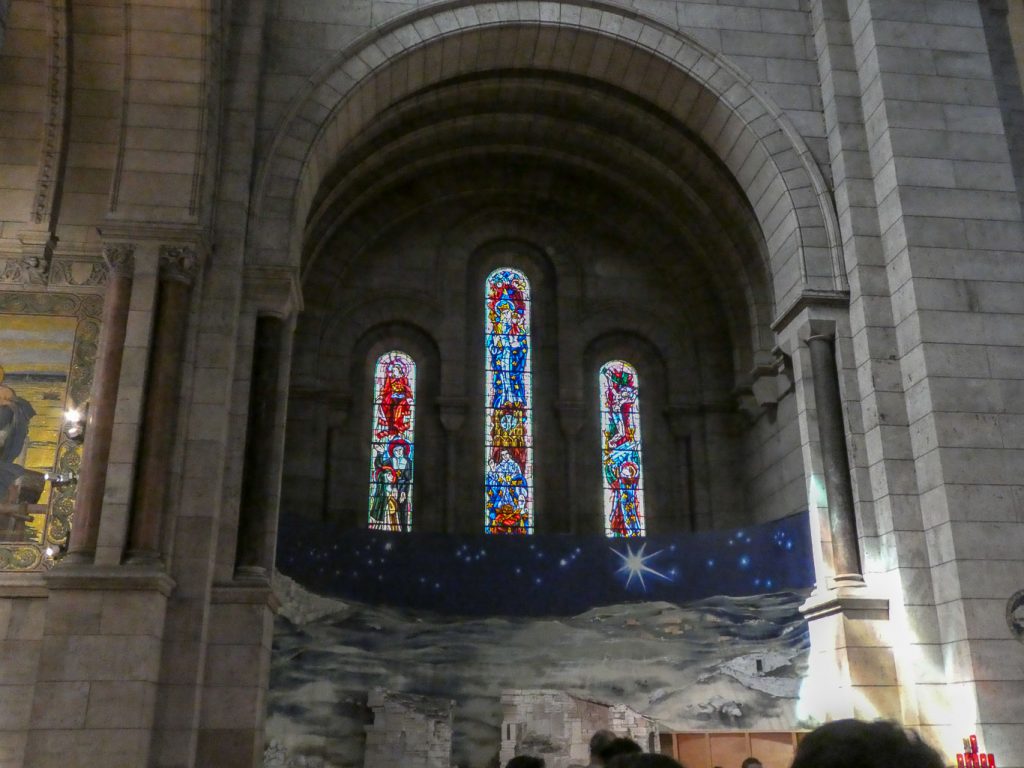
The idea of the gargoyles, which decorate the outside of the building, is to scare away evil
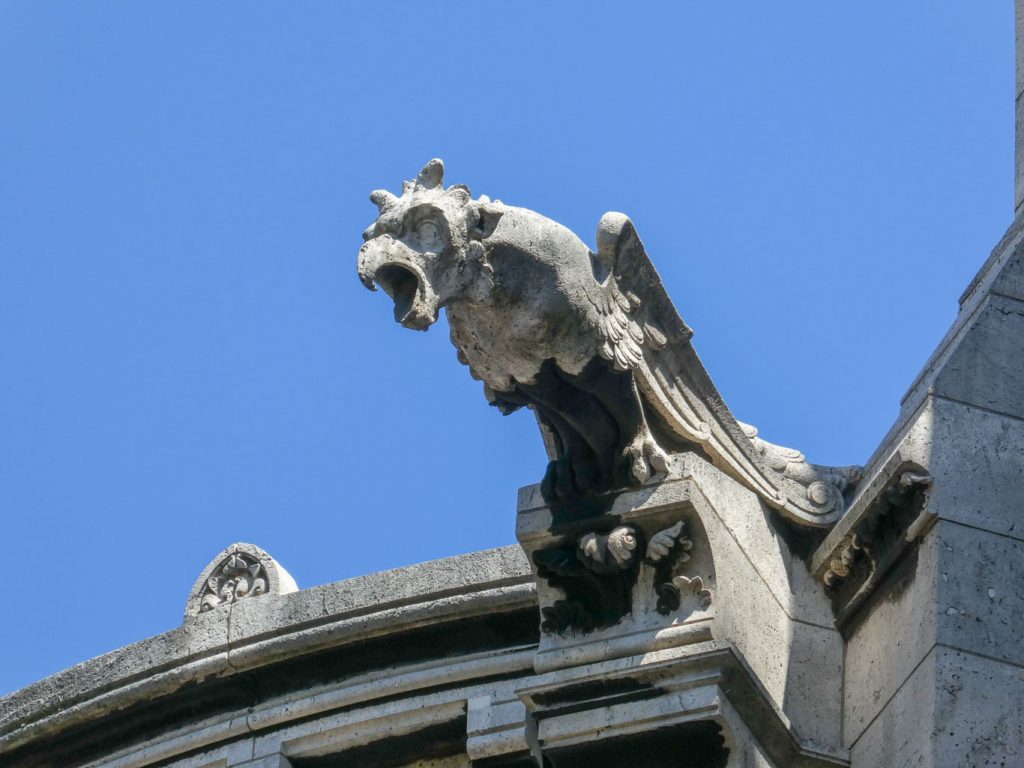
Time to explore the area a little now . . .

 And watch a few of the street artists, famous in the area.
And watch a few of the street artists, famous in the area.

I wouldn’t mind living in a house like this, would you?

There’s the ‘Le Petit Train de Montmartre’ which starts its tour just across the street from the Moulin Rouge and then for the next 40 minutes it takes you on a guided tour exploring ‘the picturesque village of Picasso and Van Gogh, from the Moulin Rouge, Sacré-Coeur Basilica, etc. €6.50 so not too expensive and something I’d like to try when we have more time.

Fancy a game of dominoes?
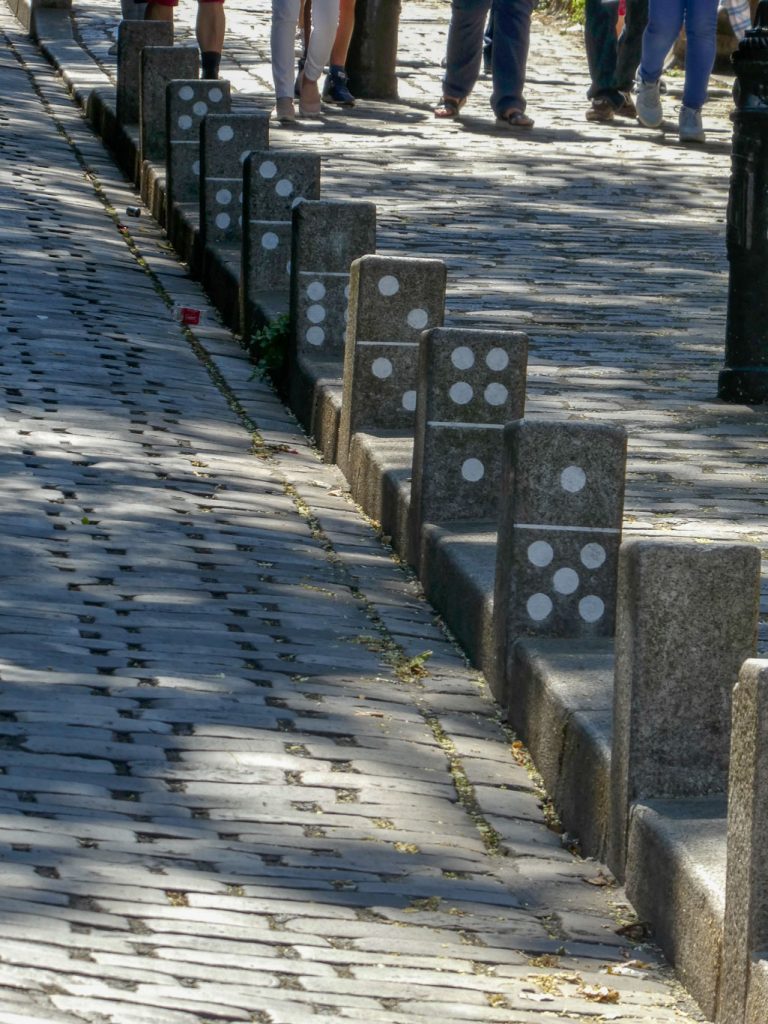
A bit of a walk down the hill and we were soon at the famous ‘Moulin Rouge’

The Moulin Rouge has been a dance hall since 1889. The Lonely Planet Guidebook (mentioned at the top of the page), describes it well. It tells us that the area was once covered in vineyards and dotted with windmills for making flour. Visitors came to to area for the wine and stayed at inns that competed for guests by putting on dance shows called ‘cabarets’. These became dance hall and today only the Moulin Rouge (‘Red Mill”) is left. The Moulin Rouge is a huge tourist attractions with nightly performances of the can-can by dancers in seriously over the top costumes with plenty of feathers and fake jewellery. There are also acts by acrobats, musicians and clowns. As an aside the guide tells us that ‘music halls became known for the cancan a scandal when it was first invented. Women in a row would kick so high you could see the long pants they wore under their skirts. The costumes these days are even more revealing.’ The area is surrounded by sex shops so we didn’t stay long!
Time to be getting back to the Gard de Nord, a bite of lunch and a fancy raspberry tart and it wasn’t long before we were back on the Eurostar and back in London. Across the road and the Cambridge train was already in the station. A fabulous few days, a great whistle stop visit to Paris which has certainly whetted my appetite to visit again and with the Eurostar it’s just so incredibly easy!
